Massage: Difference between revisions
FSeverance65 (talk | contribs) m (None) |
m (Reverted edits by FSeverance65 (talk) to last revision by Onorem) |
||
| Line 1: | Line 1: | ||
{{CMG}} | |||
__NOTOC__ | |||
{{Editor Help}} | |||
<!--INFOBOX -- SCROLL DOWN SEVERAL LINES FOR TEXT OF ARTICLE --> | |||
<div style="float:right;width:192px;margin:0 0 1em 1em;"> | |||
<table border=0> | |||
<tr><td colspan="2" align="center" bgcolor="#ffcc99">'''Massage'''</td></tr> | |||
<tr><td colspan="2" align="center">This article is part of the branches of CAM series.</td></tr> | |||
<tr><td colspan="2" align="center" bgcolor="#ffcc99">'''[[Glossary of alternative medicine#CAM|Complementary and alternative medicine]] Classifications'''</td></tr> | |||
<tr><td>[[Glossary of alternative medicine#NCCAM classifications|NCCAM]]:</td><td>[[Glossary of alternative medicine#Manipulative and body-based methods|Manipulative and body-based methods]] | |||
<tr><td>[[Glossary of alternative medicine#Modality classifications|Modality]]:</td><td>[[Glossary of alternative medicine#Professionalized modalities|Professionalized]]</td></tr> | |||
</table> | |||
</div> | |||
<!--//END OF INFOBOX--> | |||
__NOTOC__ | |||
[[Image:Massage Frankfurt.jpg|thumb|right|Massage in [[Frankfurt, Germany|Frankfurt]], [[Germany]].]] | |||
'''Massage''' is the treatment and practice of manipulation of the soft body tissues with physical, functional, i.e. mechanical, medical/therapeutic, and in some cases psychological purposes and goals.<ref>[http://www.medterms.com/script/main/art.asp?articlekey=11623 Definition of ''massage'', MedicineNet.com]</ref> The word comes from the [[French language|French]] ''massage'' "friction of kneading," possibly from [[Arabic]] ''massa'' "to touch, feel, handle" or from [[Latin]] ''massa'' "mass, dough". <ref>[http://www.etymonline.com/index.php?term=massage Online Etymology Dictionary, massage]</ref><ref>[http://m-w.com/dictionary/massage Merriam Webster Dictionary Online, massage]</ref> (In distinction the ancient [[Ancient Greek|Greek]] word for massage itself was ''anatripsis'' <ref name=Noah>{{cite web | url = http://books.google.com/books?id=KEyOi-KN0rgC&pg=PA2&lpg=PA2&dq=massage+etymology&source=web&ots=DL_HWZvu1Y&sig=_GPxSzQ6nGTOUuKWORf1xy_Nj64#PPA1,M1| title = The History of Massage: An Illustrated Survey from Around the World | last = Calvert | first = R. | publisher = Healing Arts Press| date = [[2002-04-01]]}}</ref>, and the Latin was ''frictio''.) | |||
Massage involves acting and manipulating the patient's body with pressure (structured, unstructured, stationary, and/or moving), tension, motion, or vibration done manually or with mechanical aids. Target tissues may include [[muscle]]s, [[tendons]], [[ligaments]], [[skin]], [[joints]], or other [[connective tissue]], as well as [[lymphatic]] vessels, and/or organs of the [[gastrointestinal system]]. Massage can be applied with the [[hand]]s, [[finger]]s, [[elbow]]s, [[forearm]], and [[foot|feet]]. There are over eighty different massage modalities. <ref name=nccam>{{cite web | url = http://nccam.nih.gov/health/massage/| title = Massage Therapy as CAM | publisher = The National Center for Complementary and Alternative Medicine (NCCAM)| date = [[2006-9-01]] | accessdate = 2007-09-26}}</ref> The most cited reasons for introducing massage was patient demand and perceived clinical effectiveness.<ref name=policy>{{cite web | url = http://web.ebscohost.com/ehost/pdf?vid=4&hid=113&sid=b53edf1d-ce65-438c-ab52-d14158569e4a%40sessionmgr109| title = Policy for Therapeutic Massage in an Academic Health Center: A Model for Standard Policy Development | | publisher = The Journal of Alternative and Complementary Medicine| date = [[2007]] | accessdate = 2007-09-26}} 13 (4) pp.471-475 </ref> | |||
In professional settings, massage involves the client being treated while lying on a massage table, sitting upright in a [[massage chair]], or lying on a pad on the floor. Except for modalities such as [[Acupressure]], [[Shiatsu]], [[Tui Na]], [[Massage#Thai massage|Thai Massage]], or [[Massage#Barefoot Deep Tissue|Barefoot Deep Tissue]], the massage subject is generally [[nudity|unclothed or partially unclothed]], also referred to as disrobed, and their body would be "draped" with [[towel]]s or sheets. | |||
{{TOClimit|limit=2}} | |||
==History== | |||
=== Ancient and medieval times === | |||
Writings on massage have been found in many ancient civilizations such as [[Ancient Rome|Rome]], [[Greece]], [[Japan]], [[China]], [[Egypt]], and [[India]]. <ref name=nccam/>[[Hippocrates]] wrote in [[460 BC]] that "The physician must be experienced in many things, but assuredly in rubbing." <ref name=harvard>{{cite web | url = http://web.ebscohost.com/ehost/pdf?vid=4&hid=13&sid=b53edf1d-ce65-438c-ab52-d14158569e4a%40sessionmgr109| title = Massage Therapy | publisher = Harvard Men’s Health Watch | date = [[2006-09-01]] | accessdate = 2007-09-26}} 11 (2) pp.6-7</ref> | |||
The ancient [[China|Chinese]] book called ''[[Huangdi Neijing]]'' by the [[Yellow Emperor]] recommended "massage of skin and flesh."<ref name=facts>{{cite web| url = http://www.ncbtmb.com/consumers_massage_facts.php|title = Massage Facts| publisher = National Certification Board for Therapeutic Massage & Bodywork | accessdate = 2007-09-27}}</ref> | |||
The technique of massage abortion, involving the application of pressure to the pregnant [[abdomen]], has been practiced in [[Southeast Asia]] for centuries. One of the [[bas relief]]s decorating the temple of [[Angkor Wat]] in [[Cambodia]], dated circa 1150, depicts a [[demon]] performing such an abortion upon a woman who has been sent to the [[underworld]]. This is believed to be the oldest known visual representation of abortion.<ref name="potts"> Potts, Malcolm, & Campbell, Martha. (2002). [http://big.berkeley.edu/ifplp.history.pdf History of contraception]. ''Gynecology and Obstetrics'', vol. 6, ch. 8.</ref> | |||
In [[Romania]] some illnesses were treated by a massage in which the patient was treaded on by a tame bear.<ref name="DER">''[http://dexonline.ro/search.php?cuv=c%C4%83lc%C3%A1&source=12 călcá]'' in the ''[[Dicţionarul etimologic român]]'', [[Alexandru Ciorănescu]], [[Universidad de la Laguna]], Tenerife, 1958-1966</ref>. | |||
Modern | === Modern times === | ||
'''United States:''' | |||
Massage started to become popular in the [[United States]] in the middle part of the 1800s <ref name=nccam/> and was introduced by two [[New York]] [[physicians]] based on [[Per Henrik Ling]]'s techniques developed in [[Sweden]]. <ref name=harvard/> | |||
During the 1930s and 1940s massage's influence decreased because of recent medical advancement, while in the 1970s massage's influence grew once again with a notable rise among athletes. <ref name=nccam/> Massage was used up until the 1960s and 1970s by [[nurses]] to help ease patients’ pain and help them sleep.<ref>{{cite web | url = http://www.immunesupport.com/library/showarticle.cfm/id/6151/searchtext/massage%20and%20cancer%20pain/| title = Hospitals Getting a Grip: Massage Therapy Finds Place in Patient Care for FM and More | last = MacGregor | first = H. | publisher = Los Angeles Times| date = [[2004-12-28]] | accessdate = 2007-08-31}}</ref> | |||
Because it is illegal to advertise or offer sexual services in most of the United States, such services are sometimes advertised as "massage". | |||
'''United Kingdom:''' | |||
Massage is popular in the [[United Kingdom]] today and gaining. There are many private practitioners working from there own premises as well as those who operate from commercial venues. | |||
'''Massage in sports, business and organizations:''' | |||
The [[1996 Summer Olympics]] in [[Atlanta]] was the first time that massage was offered as a core medical service. <ref name=facts/> Massage has been employed by businesses and organizations such as the [[U.S. Department of Justice]], [[Boeing]] and [[Reebok]].<ref>{{cite web | url = http://archives.cnn.com/2000/HEALTH/alternative/12/28/massage.therapy/index.html| title = Massage craze: Hands-on therapy attracting more patients| last = Goodman | first = T. | publisher = CNN| date = [[2000-12-28]] | accessdate = 2007-08-31}}</ref> | |||
==Equipment== | |||
==== Massage Table ==== | |||
[[Image:Massage Bench.jpg|thumb|right|Massage table used in [[Kerala]]-style Ayurveda Abhyanga massage.]] | |||
A typical commercial [[massage table]] has an easily cleaned, heavily padded surface, and a horseshoe-shaped head support that allows the client to breathe easily while lying face down and can be stationary or portable. An [[orthopedic pillow]] or bolster can be used to correct body positioning. | |||
==== Massage Chair ==== | |||
[[Image:Massage Chairs in VivoCity.jpg|thumb|right|Mechanical massage chairs at [[VivoCity]] in [[Singapore]].]] | |||
Ergonomically designed [[massage chairs]] for positioning a person who will be receiving a massage, similar in function to a massage table. Chairs may be either stationary or portable models. | |||
Massage chairs are easier for the practitioner to maneuver than massage tables, and clients do not need to disrobe to receive a chair massage. Due to these two factors, chair massage is often performed in settings such as corporate offices, outdoor festivals, shopping malls, and other public locations. | |||
====Oil==== | |||
Many different types of oils can be used including fractionated [[coconut oil]], [[grape seed oil]], [[macadamia oil]], [[sesame oil]], [[pecan oil]], and [[mustard oil]]. [[Arnica]], from the flowers or leaves of the ''[[Arnica montana]]''. Often uses [[olive oil]] as a base when used medicinally, or [[almond oil]] when used as a massage oil.<ref>{{cite web|url=http://www.vitalityworks.com/vitality/Productinfo/A/Arnica%20Oil.htm|title=Arnica Oil|publisher=Vitality Works|accessdate=2006-08-11}}</ref> | |||
[[Aromatherapy]] oils such as [[neroli oil]] and [[pine oil]] can also be mixed with [[carrier oil]]s. | |||
====Mechanical aids==== | |||
Electronic [[massage chair]]s are commercially available, which operate without any manual help. [[Lexus]] cars of the fourth generation [[Lexus LS#Fourth generation (USF40 / USF41)|LS]] include [[shiatsu]] and shoulder massage systems. <ref name=engineering>{{cite web|url=http://www.sae.org/servlets/pressRoom?OBJECT_TYPE=PressReleases&PAGE=showRelease&RELEASE_ID=548|title=Automotive Engineering International Magazine Names Lexus LS 460 As 2007 Best Engineered Vehicle|Society of Automotive Engineers|date=2007-04-10|publisher=SAE International|accessdate=2007-05-06}}</ref> | |||
== Massage methods == | |||
:''Different specialized massage methods sorted in alphabetical order. | |||
'' | |||
Massage can be performed by a professional '''Massage Practitioner''', or by other [[Health profession|health care professionals]], such as [[chiropractor]]s, [[osteopath]], [[Athletic trainer]]s, and/or [[Physical therapy|physical therapists]]. Massage therapists work in [[hospitals]] as [[Allied health professions|allied health professioners]], in [[nursing homes]], sports and fitness facilities, [[destination spa|spas]], [[beauty salon]]s, [[cruise ships]], private offices, and travel to private residences or businesses. <ref name=nccam/> [[Contraindications]] to massage include, [[deep vein thrombosis]], [[bleeding disorders]] or taking blood thinners such as [[Warfarin]], damaged blood vessels, weakened bones from [[cancer]], [[osteoporosis]], or [[fractures]], and [[fever]]. <ref name=nccam/> | |||
=== Acupressure === | |||
{{main|Acupressure}} | |||
=== Ayurvedic Abhyanga massage === | |||
[[Image:tractionmassage.JPG|thumb|right|Traction Massage in marma therapy given in '''Sreepathy cvn kalari''' for inter vertebral disc prolapse ]] | |||
[[Ayurveda]] is a natural health care system originating in [[India]] over 5,000 years ago. It incorporates massage, [[yoga]], [[meditation]] and [[Herbalism|herbal]] remedies. Ayurvedic Massage, also known as Abhyanga part of [[Panchakarma]] is usually performed by one or two therapists using a heated blend of herbal oils that are believed to be based on the body's [[dosha]].The aim is to loosen the excess doshas through techniques such as kneading, rubbing, and squeezing. The feet are used in chavutti thirummal, a specialized technique where the therapist suspends himself by a rope from the ceiling to apply extra pressure with his feet. | |||
=== Barefoot deep tissue === | |||
Barefoot deep tissue is a blend of Eastern barefoot techniques with Western manual therapy. Clients typically wear loose clothes while lying on a mat on the floor in [[Supine position|supine]], [[prone]] and [[side-lying]] positions with [[pillows]] or bolsters with no oil used. Because the therapist can apply a broad range of pressure with ease and does not have to strain, more effort and concentration can be used to sense and manipulate tissue, release [[fascia]], as well as search for and attack [[trigger points]], regardless of client's size or build. | |||
John Harris, who worked in the [[1984 Olympics]] developed this modality. | |||
=== Bowen therapy === | |||
{{main|Bowen therapy}} | |||
Bowen technique involves a rolling type movement over fascia, muscles, ligaments, tendons and joints. It is said not to involve deep or prolonged contact with muscle tissues as in most kinds of massage, but claims to relieve muscle tensions and strains and to restore normal lymphatic flow. It is based on practices developed by Australian Tom Bowen.<ref>[http://www.bowen.asn.au/html/ Bowen Therapists Federation of Australia]</ref> | |||
[[Image:'07 Massage at Novell 620.jpg|thumb|right||Chair massage at [[Novell]] BrainShare [[2007]].]] | |||
=== Breema === | |||
{{main|Breema}} | |||
Breema bodywork is performed on the floor with the recipient fully clothed. It consists of rhythmical and gentle leans and stretches. Fifty minute sessions are common. There are also self-Breema exercises. The essence of Breema is expressed in the Nine Principles of Harmony. | |||
=== Chair massage === | |||
"Seated massage" (also refereed to as chair-massage), is done in a variety of diverse settings, e.g., business,corporate and clinical settings, and in public areas such as airports, shopping centers, sport clubs, and salons. A seated-massage typically lasts 10-30 minutes, and is performed while fully clothed. Seated massage is an excellent technique to use for working on the neck, shoulders and upper back areas of the body. Due to the way the individual is positioned, seated massage allows the therapist to work with the force of gravity while doing a treatment. | |||
[[Image:Indian Head Massage.jpg|thumb|right|"Champie" ([[Indian Head Massage]]) in [[Mumbai, Maharashtra|Mumbai]], [[Maharashtra]], [[India]].]] | |||
=== Champissage === | |||
{{main|Champissage}} | |||
Champissage or (Indian head massage) has been used in [[India]] for centuries. It combines massage with the more subtle form of [[chakra]] balancing. It is normally done by applying oil over the body. Also called 'champi' or Maalis. The word ''[[wikt:Shampoo|shampoo]]'' in [[English language|English]] usage dates back to [[1762]], with the meaning "to [[massage]]". The word was a [[Loanword|loan]] from Anglo-Indian ''shampoo'', in turn from [[Hindi]] ''chāmpo'' (चाँपो {{IPA|/tʃãːpoː/}}), [[imperative mood|imperative]] of ''chāmpnā'' (चाँपना {{IPA|/tʃãːpnaː/}}), "to smear, knead the muscles, massage". It itself comes from Sanskrit/Hindi word "champā" (चम्पा {{IPA|/tʃəmpaː/}}), the flowers of the plant ''[[Michelia champaca]]'' which have traditionally been used to make fragrant hair-oil. It is often performed by the barber after a haircut on the head, shoulders, arms, and neck. | |||
The term and service was introduced by a [[Bengali people|Bengali]] entrepreneur [[Sake Dean Mahomet|Sake Dean Mahomed]], who opened a shampooing bath known as 'Mahomed's Indian Vapour Baths' in [[Brighton]], [[England]] in 1759. | |||
=== Craniosacral therapy === | |||
{{main|Craniosacral therapy}} | |||
Craniosacral therapy is a gentle, hands-on method of evaluating the functioning of the craniosacral system, and is often mistakenly referred to as a type of massage. It works through using the body's own self-correcting mechanisms rather than the application of physical force from the practitioner. When used by a massage practitioner, craniosacral therapy can usefully complement the massage treatment, | |||
=== Deep tissue massage === | |||
Deep tissue techniques are generally designed for more focused massage work. Working a specific joint, muscle or muscle group, the practitioner can access deeper layers of the soft tissue. Starting superficially and easing into the depth of the muscle slowly often allows more movement. If the pressure is applied too deeply or too quickly, the muscle may tighten to protect that area, and unnecessary damage or inflammation can be induced. Very little lubricant is used as the pressure doesn't travel much over the skin.<br /><br /> | |||
The most commonly used 'tools' during deep tissue massage may include, 3 and 6 fingers, reinforced fingers, knuckles, a flat elbow, opposing thumbs, the heel of the hand or foot, and the forearm. Deep tissue is similar to [[Myofascial Release]]. | |||
Deep muscle therapy was created by [[Therese Pfrimmer]] of [[Canada]]. | |||
=== Horstmann technique === | |||
Practical technique that works by initially balancing the "energy field" and then holding on special energy points while mobilising limbs. | |||
=== Esalen Massage === | |||
{{main|Esalen Massage}} | |||
Esalen Massage was developed by [[Charlotte Selver]] and works with gentle rocking of the body, passive joint exercises and deep structural work on the muscles and joints, together with an energetic balancing of the body. | |||
=== Infant massage === | |||
Shantala massage is an ancient Indian massage technique with a rhythmic character, given to massage babies and children. It was introduced into Western society by Dr. Frederique Leboyer, a French obstetrician. | |||
=== Lomilomi === | |||
{{main|Lomilomi}} | |||
[[Image:Massage.jpg|thumb|Massage in [[Tarifa, Spain|Tarifa]], [[Spain]].]] | |||
Lomilomi is the traditional massage of [[Hawaii]]. As an indigenous practice, it varies by island and by family. The styles most known today are those of Auntie Margaret Machado of the island of Hawaii, Uncle Kalua Kaiahua of Maui and Oahu, and Kahu Abraham Kawaii of Kaua'i, who called his style ''Kahuna Bodywork''. Other names given to massage performed in Hawaii are ''temple style'', ''lomi lomi'', ''lomi lomi nui'', ''romi kapa rere'', ''romi romi'' and ''ma-uri''. Some of these styles may be traditional, and others may have been influenced by or created in modern times. The purported Lomilomi massage given by [[Barbra Streisand]] to [[Robert De Niro]] in "[[Meet the Fockers]]" was not an accurate representation of the style. | |||
=== Medical massage === | |||
Massage used in the medical field includes [[Manual lymphatic drainage]] used for [[lymphedema]] <ref name=nccam/> which can be used in conjunction with the treatment of [[breast cancer]]. Carotid sinus massage is used to diagnose carotid sinus syncope and is sometimes useful for differentiating [[supraventricular tachycardia]] (SVT) from [[ventricular tachycardia]]. It, like the [[valsalva maneuver]], is a therapy for SVT.<ref>Lim SH, Anantharaman V, Teo WS, Goh PP, Tan AT. Comparison of treatment of supraventricular tachycardia by Valsalva maneuver and carotid sinus massage. Ann Emerg Med. 1998 Jan;31(1):30-5. PMID 9437338</ref> However, it is less effective than pharmaceutical management of SVT with [[verapamil]] or [[adenosine]].<ref>Ballo P, Bernabo D, Faraguti SA. Heart rate is a predictor of success in the treatment of adults with symptomatic paroxysmal supraventricular tachycardia. Eur Heart J. 2004 Aug;25(15):1310-7. PMID 15288158</ref> | |||
=== Myofascial release === | |||
Myofascial release refers to the manual massage technique for [[stretching]] the [[fascia]] and releasing bonds between [[fascia]], [[integument]], and [[muscle]]s with the goal of eliminating [[pain]], increasing [[range of motion]] and [[equilibrioception]]. Injuries, stress, trauma, overuse and poor posture can cause restriction to fascia. This is usually done by applying shear compression or tension in various directions, or by skin rolling. Myofascial release originators come from [[Physical Therapy]] and from [[Structural Integration]] ([[Rolfing]]); its current developers include [[John Barnes]], [[Art Riggs]], [[Michael Stanborough]], [[Tom Myers]], [[Til Luchau]] and [[Michael Leahy]], the originator of a complete regime called Active Release Technique or ART. | |||
Proprioceptive Neuromuscular Facilitation (PNF) and myofacial techniques are believed to lengthen tight/facilitated muscles while fiber activation techniques are believed tone weak/inhibited muscles. | |||
=== Neuromuscular therapy === | |||
Neuromuscular Therapy (NMT) is used for pain relief. Perceived imbalances in [[Human position]] are assessed initially through a postural [[assessment]]. These are then addressed through systematic and site specific massage. NMT was developed in the 1930s by Dr. Stanley Leif, current practitioners include [[Paul St. John]]. | |||
=== Nihon Kaifuku Anma - Traditional Japanese massage === | |||
Introduced to Japan about 1300 years ago. [[Anma]] is deep tissue work using no oils and is based on kneading movements. Shiatsu massage grew out of this rich tradition. | |||
=== Pregnancy massage === | |||
[[Doula]]s will often use massage in an attempt to smooth the labor process. | |||
=== Reflexology massage === | |||
[[Image:Pebble sandals.jpg|thumb|right|Pebble massage sandals from [[Dalian, China|Dalian]], [[China]].]] | |||
[[Reflexology]], also called Foot zone therapy, is traditionally practiced without lotion, as the pressure points on the feet are stimulated by thumb and finger walking, as well as static pressure. Foot massage practitioners believe that the ailment of an internal organ will be associated with the [[nerve]] ending on the sole of the foot. As pressure is applied to the sole, theory holds that a healthy patient should not feel any strong pain. This theory is based on a perceived energetic flow of "meridians" in the body, also known as Chi. | |||
Before the massage, the patient's feet are soaked for about ten minutes in a foot bath, typically a solution of hot water and Chinese herbs. The practitioner rubs and massages the painful spots to break down rough spots and accumulated ''crystals'' which have not been scientifically researched. Based on this idea, some shoe liners are made with pressure points to stimulate the soles of the feet. | |||
=== Shiatsu === | |||
{{main|Shiatsu}} | |||
Shiatsu (指圧) is a form of Japanese massage that uses thumb pressure and works along the same energy meridians as [[acupressure]] and incorporates [[stretching]]. While receiving Shiatsu, you are fully clothed while laying on a mat on the floor. | |||
=== Soft tissue therapy === | |||
Treatment techniques include [[trigger point]] therapy, [[myofascial Release]], friction for [[Adhesion (medicine)|adhesions]] between fascial layers and muscles. Sustained finger pressure to alleviate hypertonic, or tight, areas within muscle and fascia, active Release therapies, and deep tissue massage are all derivatives of [[soft tissue therapy]]. Different types of [[stretching]] such as [[static stretching]], [[dynamic stretching]], and/or [[PNF stretching]] (proprioceptive neuromuscular facilitation). | |||
Another form of Soft tissue therapy is Muscle energy technique (MET) which uses [[reciprocal inhibition]] (RI) which is when the therapist uses a client’s muscle to stretch the opposing muscle. The therapist takes the muscle that they are wishing to stretch to its full [[range of motion]]. The therapist then gets the client to use the opposing muscle by moving away from the therapist. When the client relaxes the therapist then moves the muscle in an attempt to realign the muscle fibers. | |||
[[Image:Triathlon massage Australia.jpg|thumb|right|Massage therapist working at a [[Triathlon]] in [[Fremantle, Western Australia| Fremantle]], [[Western Australia]], [[Australia]].]] | |||
=== Sports massage === | |||
A Sports Massage can be described as massage that has derived from the Swedish style massage specifically to treat sporting injuries and sports persons, pre and post-event. The same techniques of effleurage, petrissage, friction, tapotement, compression, and vibration are employed; however, the movements are often reinforced, which makes the effect much deeper, and are usually targeted towards specific muscles and tissues to treat them in isolation, as well as holistically. | |||
A Sports Massage may involve treating the entire body, as part of a training routine, or more usually a specific area is treated due to a particular muscle strain or injury. | |||
Due to the nature of various sports and athletic pursuits, clients may attend for treatment with recent injuries. Direct pressure over the injury site is specifically contra-indicated for 48-72 hours after the occurrence; this over and above the standard massage contra-indications. | |||
[[Neuro Muscular Technique]] (NMT) and [[Muscle Energy Technique]] (MET) are often used by the Sports Massage Therapist to treat high degrees of tension or 'knotting' of specific muscles. These techniques are extremely useful in relaxing the muscles sufficiently to allow the therapist perform a more standard massage routine. | |||
[[Image:Hot stone massage.jpg|thumb|right|A hot [[stone massage]] being performed in [[Oxnard, California|Oxnard]], [[California]].]] | |||
=== Stone massage === | |||
Heated stones were used by [[Egyptians]], [[Indigenous peoples of the Americas|Native American]]s and in [[Lomilomi]] massage. Smooth hot or cold stones, usually basalt or marble, are used to massage the body. When heated stones are used, muscles relax, allowing the massage therapist to work deeper into the muscle. [[Energy medicine]] is sometimes incorporated into [[stone massage]]. Stones are heated in hot water and are placed under the back, along both sides of the spine, and on top of the torso and are believed to heat the chakra or meridians centers. Heated stones coated in oil are then used directly in the hands of the therapist delivering various massaging strokes. | |||
=== Structural Integration === | |||
[[Rolfing]], a method of [[Structural Integration]], works with realigning the body structurally and [[human gait]]. | |||
=== Swedish massage === | |||
This style utilizes long, flowing strokes, often but not necessarily in the direction of the [[heart]]. There are six basic strokes: [[effleurage]] from the French ''effleurer'', 'to skim over', [[petrissage]] from the French pétrir, 'to knead', friction, [[tapotement]], compression, and vibration. Petrissage is a [[kneading]] movement with the whole palm or finger tips, using wringing, skin rolling, compression, and/or lifting. Petrissage is usually applied vertically to the muscle tissue. [[Oil]], [[Cream (pharmaceutical)|cream]], or [[lotion]] is applied on the skin to reduce friction and allow smooth strokes. Effleurage consists of long, flowing or gliding strokes, performed with open hands. In many massage sessions, effleurage is used as the initial type of stroking, as it has a calming effect when performed slowly. Swedish massage has shown to be helpful in reducing pain, [[joint stiffness]], and improving function in patients with [[osteoarthritis]] of the knee over a period of eight weeks. <ref>{{cite journal |author=Robertshawe P.|title= Massage for Osteoarthritis of the Knee|journal=Journal of the Australian Traditional-Medicine Society |volume=13 |issue= 2 |pages=87 |year=June 2007 |doi=}}</ref> | |||
==== History ==== | |||
This style of massage is generally attributed to the Swedish fencing master and gymnastics teacher [[Per Henrik Ling]] (1776-1839). However, it was in fact the Dutch practitioner [[Johan Georg Mezger]] (1838-1909) who adopted the French names to denote the basic strokes. The term Swedish Movement System was transposed to Swedish Massage System sometime during the second half of the [[19th century]]. Ling’s system was the Swedish Movement System or Swedish Gymnastic Movement System. This may be how he has become incorrectly associated for so long with Swedish massage. | |||
<ref>{{cite web | url = http://www.massagemag.com/Magazine/2002/issue100/history100.php| title = Pages from history: Swedish massage| last = Calver | first = R| publisher = Massage Magazine| accessdate = 2006-12-25}}</ref> | |||
[[Image:Aikido massage.jpg|thumb|right|The [[Aikikai]] foundation of the [[Japanese martial art]] [[Aikido]] incorporates massage into their routine, in [[Slovenia]].]] | |||
=== Tai Ji/Tai Chi massage === | |||
This massage uses the natural principles of Yin and Yang to achieve balance in the energies of the body. Practitioners of [[Tai Ji]] believe that it uses [[Tao]] and deals with [[Qi]] blockages. | |||
=== Thai massage === | |||
{{main|Thai massage}} | |||
Known in Thailand as นวดแผนโบราณ (Nuat phaen boran, IPA {{IPA|[nuɑt pʰɛn boraːn]}}), meaning "ancient/traditional massage", Thai massage is also known as Thai ancient massage, traditional Thai massage, Thai yoga massage, yoga massage, Thai classical massage, Thai bodywork, passive yoga or assisted yoga. Thai massage originated in India based and is based on [[Ayurveda]] and [[yoga]], thereafter becoming popular in ancient [[Siam]], now known as [[Thailand]]. It was believed that the massage art was brought over to Thailand by Shivago Komarpaj (Jivaka Kumarabhacca), a contemporary of [[Gautama Buddha]] over 2500 years ago. | |||
The receiver is put into many yoga like positions during the course of the massage. In the northern style based out of [[Chiang Mai]], Thailand there is a lot of stretching movements, unlike the southern style where acupressure is emphasized. | |||
[[Image:Thai massage.jpg|thumb|right|Drawings of [[accupressure]] points on [[Sen]] lines at [[Wat Pho]] temple in [[Phra Nakhon|Phra Nakhon district]], [[Bangkok]], [[Thailand]].]] | |||
The massage recipient changes into loose, comfortable clothes and lies on a mat or firm mattress on the floor. (It can be done solo or in a group of a dozen or so patients in the same large room.) The massage practitioner leans on the recipient's body using hands and usually straight forearms locked at the elbow to apply firm rhythmic pressure. The massage generally follows the Sen lines on the body — somewhat analogous to meridians or [[Channel (Chinese medicine)]] and Indian [[nadis]]. Legs and feet of the giver can be used to fixate the body or limbs of the recipient. In other styles, hands fixate the body, while the feet do the massaging action. Oil is not used in traditional Thai Massage. A full Thai massage session typically lasts two hours or more, and includes rhythmic pressing and stretching of the entire body; this may include pulling fingers, toes, ears, cracking the knuckles, walking on the recipient's back, and arching the recipient's into [[bhujangasana]] or (cobra position). There is a standard procedure and rhythm to this massage. In Thailand a two hour massage might cost around 300 [[Thai baht]] (US $8 in [[2005]]) depending on location (it may cost ten times more inside a five star hotel). | |||
[[Image:Thai Massage.jpg|thumb|right|[[Nuat phaen boran]] or Thai massage, side-lying position in [[Frankfurt, Germany|Frankfurt]], [[Germany]].]] | |||
Note: The traditional therapeutic practice of Thai massage should not be confused with the sexual service of the same name that is available in some hotels and brothels. Sometimes the traditional therapeutic Thai Massage, or ancient massage, is referred to as "old lady massage", while the sexual practice, which has nothing to do with therapeutic traditional massage is called "young lady massage". | |||
=== Traditional Chinese massage === | |||
[[Tui Na]] (推拿) focusing on pushing, stretching and kneading the muscle. [[Zhi Ya]] (指壓) is similar to Tui Na massage except it focuses more on pinching and pressing at [[acupressure]] points. They are both based on principles from [[Traditional Chinese Medicine]]. | |||
=== Trager Approach === | |||
{{main|Trager Approach}} | |||
The Trager Approach combines movement, massage and education. | |||
=== Trigger point therapy === | |||
This can also be called pressure point massage. <ref name=nccam/> A [[trigger point]] is an area of a muscle (about 50 cells) that may refer pain sensations to other parts of the body. Manual pressure is applied to these points. This work was founded by Dr. [[Janet G. Travell]], U.S. President [[John F. Kennedy]]'s physician and [[David Simons]]. This work can be incorporated into other styles of massage therapy such as [[neuromuscular therapy]] (NMT) or Swedish. | |||
=== Visceral manipulation === | |||
One form is Mayan abdominal massage which is practiced in many countries in Latin America. This type of massage was developed by Don [[Elijio Panti]] and Dr. Rosita Arvigo of [[Peru]]. | |||
[[Mantak Chia]] introduced a form of [[abdomen]] massage called ''Chi Nei Tsang'', which he teaches, helps to "clears negative emotions" (in the form of "bad winds" or "sick winds") which gather near the [[navel]].<ref>Chia, Mantak & Maneewan. ''Chi Nei Tsang: Internal Organ Chi Massage''. : Healing Tao Books, 1991. ISBN 0935621350.</ref> | |||
[[Image:Jacusi.jpg|thumb|right|Massager Jacuzzi in the [[Santiago Bernabéu Stadium]].]] | |||
=== Watsu === | |||
{{main|Watsu}} | |||
Watsu is the combination of [[hydrotherapy]] and [[Shiatsu]] developed by [[Harold Dull]] in his time spent at [[Harbin Hot Springs]] near [[Middletown, California|Middletown]], [[California]], [[USA]]. The work is done in skin temperature water with both the therapist and practitioner in the water, usually a pool which is between 3.5 ft to 4 ft. (100–120 cm) deep. The work entails much movement in the water and practitioners believe that it incorporates the activation of the energy lines derived from Shiatsu. | |||
==Associated methods== | |||
Many types of practices are associated with massage and include [[Bodywork (alternative medicine)]], [[manual therapy]], [[energy medicine]], and [[breathwork]]. Other names for massage and related practices include hands-on work, body/somatic therapy, and somatic movement education. Body-mind integration techniques stress self-awareness and movement over physical manipulations by a practitioner. Therapies related to movement awareness/education are closer to [[Dance therapy|Dance and movement therapies]]. Massage can also have connections with the [[New Age]] movement and [[alternative medicine]] as well as being used by mainstream medical practitioners. | |||
==Beneficial effects== | |||
Peer-reviewed medical research has shown that the benefits of massage include [[Analgesia|pain relief]], reduced trait [[anxiety]] and [[Depression (mood)|depression]], and temporarily reduced blood pressure, heart rate, and state anxiety.<ref name= Meta/> Theories behind what massage might do include blocking [[nociception]] ([[gate control theory]]), activating the [[parasympathetic nervous system]] which may stimulate the release of [[endorphins]] and [[serotonin]], preventing [[fibrosis]] or [[scar tissue]], increasing the flow of [[lymph]], and improving [[sleep]]<ref name=nccam/> but such effects are yet to be supported by well designed clinical studies. | |||
Massage is hindered from reaching the [[Gold standard (test)|gold standard]] of [[Scientific method|scientific research]] which includes [[placebo]]-controlled and [[Blind experiment|double blind]] [[clinical trial]]s.<ref name=minn>{{cite web | url = http://takingcharge.csh.umn.edu/therapies/massage/research| title = What Does the Research Say?| last = Evans | first = R. | publisher = Regents of the University of Minnesota| date = [[2006]] | accessdate = 2007-12-06}}</ref> <ref name=anatomy>{{cite web | url = http://www.massagetherapyfoundation.org/pdf/Anatomy%20of%20a%20research%20article.pdf| title = Anatomy Of A Research Article| last = Muscolino | first = J. | publisher = Massage Therapy Foundation| date = [[2004]] | accessdate = 2007-12-06}}</ref> Developing a "sham" [[manual therapy]] for massage would be difficult since even light touch massage could not be assumed to be completely devoid of effects on the subject.<ref name=minn/> It would also be difficult to find a subject that would not notice that they were getting less of a massage and it would be impossible to blind the therapist.<ref name=minn/> Massage can employ [[randomized controlled trials]] which are [[published]] in [[Medical peer review|peer reviewed]] [[medical journal]]s.<ref name=minn/> This type of study could increase the [[credibility]] of the profession because it displays that purported therapeutic effects are [[Reproducibility|reproducible]].<ref name=anatomy/> | |||
===Single dose effects=== | |||
'''Pain relief:''' | |||
Relief from pain due to [[musculoskeletal]] injuries and other causes is cited as a major benefit of massage.<ref name=nccam/> In one study, [[cancer]] patients self-reported symptomatic relief of pain.<ref name=ncbi> {{cite web | url = http://www.ncbi.nlm.nih.gov/sites/entrez?Db=pubmed&Cmd=ShowDetailView&TermToSearch=15336336| title = Massage therapy for symptom control: outcome study at a major cancer center.| publisher = NCBI PubMed| date = [[2004-09-12]] | accessdate = 2007-09-11}}</ref> <ref>{{cite web | author = Grealish L, Lomasney A, Whiteman B. |year=[[2000]] | title=Foot massage. A nursing intervention to modify the distressing symptoms of pain and nausea in patients hospitalized with cancer (abstract)| publisher=PubMed NCBI|url=http://www.ncbi.nlm.nih.gov/entrez/query.fcgi?cmd=retrieve&db=pubmed&list_uids=10851775&dopt=Abstract | accessdate =2006-03-07}}</ref> This study, however, did not include a no treatment or placebo control group so these effect may be due to the [[placebo effect]] or [[regression towards the mean]]. Massage can also relieve [[tension headaches]]. [[Acupressure]] or pressure point massage may be more beneficial than classic Swedish massage in relieving [[back pain]].<ref name=pmid12076429>{{cite journal | author = Furlan A, Brosseau L, Imamura M, Irvin E | title = Massage for low back pain. | journal = Cochrane Database Syst Rev | volume = | issue = | pages = CD001929 | year = | id = PMID 12076429}}</ref> However, a meta-study conducted by scientists at the University of Illinois at Urbana-Champaign failed to find a statistically significant reduction in pain immediately following treatment. <ref name= Meta> {{cite web | url = http://www.anatomyfacts.com/Research/Massage%20Journal%20Club/January07/Moyer.pdf | title = A Meta-Analysis of Massage Therapy Research.| | publisher = Psychological Bulletin | date = [[2004]] | accessdate = 2008-01-12}}</ref> | |||
'''State anxiety:''' | |||
Massage has been shown to reduce state [[anxiety]], a transient measure of anxiety in a given situation. <ref name= Meta/> | |||
'''Blood pressure and heart rate:''' | |||
Massage has been shown to reduce blood pressure and heart rate as temporary effects. <ref name= Meta/> | |||
'''Attention:''' | |||
After massage, [[EEG]] patterns indicate enhanced performance and alertness on [[mathematical]] computations, with the effects perhaps being mediated by decreased stress [[hormones]]. | |||
'''Other:''' | |||
Massage also stimulates the [[immune system]]<ref> {{cite journal| author= Kuriyama, H.| title=Immunological and Psychological Benefits of Aromatherapy Massage (abstract)| journal=Evidence-based Complementary and Alternative Medicine| year=2005 | pages=179-184 | volume=2 | issue=2| url= http://www.pubmedcentral.nih.gov/articlerender.fcgi?tool=pmcentrez&artid=1142199&rendertype | doi = 10.1093/ecam/neh087 <!--Retrieved from CrossRef by DOI bot-->}} | |||
</ref> by increasing [[peripheral blood lymphocytes]] (PBLs). However, this immune system effect is only observed in aromatherapy massage, which includes [[sweet almond oil]], [[lavender oil]], [[cypress oil]], and [[sweet marjoram oil]]. It is unclear whether this effect persists over the long term. | |||
===Multiple dose effects=== | |||
'''Pain relief:''' | |||
When combined with education and exercises, massage might help sub-acute, chronic, non-specific [[low back pain]]. <ref name= Furlan > {{cite web | url = http://www.ncbi.nlm.nih.gov/sites/entrez | title = Massage for low back pain.| | publisher = NCBI PubMed| date = [[2002]] | accessdate = 2007-09-28}}</ref> Furthermore, massage has been shown to reduce pain experienced in the days or weeks after treatment. <ref name= Meta/> | |||
'''Trait anxiety:''' | |||
Massage has been shown to reduce trait [[anxiety]]; a person's general susceptibility to anxiety. <ref name= Meta/> | |||
'''Depression:''' | |||
Massage has been shown to reduce subclinical [[Depression (mood)|depression]]. <ref name= Meta/> | |||
'''Diseases:''' | |||
Massage, involving stretching, has been shown to help with [[spastic diplegia]] resulting from [[Cerebral palsy]] in a small pilot study.<ref name="pmid17355474">{{cite journal |author=Macgregor R, Campbell R, Gladden MH, Tennant N, Young D |title=Effects of massage on the mechanical behaviour of muscles in adolescents with spastic diplegia: a pilot study |journal=Developmental medicine and child neurology |volume=49 |issue=3 |pages=187-191 |year=2007 |pmid=17355474}}</ref> The researchers warn that these results should "be viewed with caution until a double-blind controlled trial can be conducted". | |||
Massage has been used in an effort to improve symptoms, disease progression, and quality of life in [[HIV]] patients, however, this treatment is not scientifically supported.<ref name=Saltmarsh >{{cite journal |author=Saltmarsh, S.|title=Voodoo or valid? Alternative therapies benefit those living with HIV |journal=Positively Aware | volume=3 | issue=16|pages=46 |year=2006 | pmid=16479668|url=http://www.tpan.com/publications/pa/may_jun_05/voodoo.shtml}}</ref> | |||
==Regulation== | |||
In the USA there are about 90,000 massage therapists. <ref name=harvard/> Training programs in the US are typically 500–1000 hours in length, and can award a certificate, diploma, or degree depending on the particular school. <ref name=overview>{{cite web | url = http://nccam.nih.gov/news/upcomingmeetings/abstracts_mt/overview_US.htm| title = Overview of Manual Therapy Use in the U.S.| last = Kahn | first = J. | publisher = The National Center for Complementary and Alternative Medicine (NCCAM)| date = [[2005-06-10]] | accessdate = 2007-09-26}}</ref> There are around 1,300 programs training massage therapists in the country and study will often include [[anatomy and physiology]], [[kinesiology]], massage techniques, [[first aid]] and [[CPR]], [[business]], [[ethical]] and [[legal]] issues, and hands on practice along with [[continuing education]] requirements if regulated. <ref name=nccam/> The Commission on Massage Therapy Accreditation (COMTA) is one of the organizations that works with massage schools in the U.S.. <ref name=policy/> | |||
38 states and the [[District of Columbia]] require some type of licencing for massage therapists. <ref name=stellin>{{cite web | url = http://www.nytimes.com/2007/07/15/business/yourmoney/15spa.html| title = Beyond the Body Wrap: What Makes a Spa Stand Out? | last = Stellin | first = S. | publisher = New York Times| date =[[2007-07-15]] | accessdate = 2007-09-20}}</ref> | |||
In the US, 32 states use the [[National Certification Board for Therapeutic Massage and Bodywork]]'s certification program as a basis for granting licenses either by rule or [[statute]]. <ref>{{cite web| url = http://www.ncbtmb.org/about_required_states.php| |title = States that require NCBTMB exams| publisher = National Certification Board for Therapeutic Massage and Bodywork| accessdate = 2007-09-27}}</ref> The National Board grants the designation Nationally Certified in Therapeutic Massage and Bodywork (NCTMB). There are two tests available and you can become certified through a porfolio process if you have equivalent training and experience. <ref>{{cite web| url = http://www.ncbtmb.com/applicants_what_you_need_to_know.php| |title = What you need to know| publisher = National Certification Board for Therapeutic Massage and Bodywork| accessdate = 2007-09-27}}</ref> Between 10-20% of towns or counties regulate the [[profession]]. <ref name=law>{{cite web| url = http://www.naturalhealers.com/qa/massage.html|title = Massage Therapy Law and Licensure and States Regulating Massage| publisher = Natural Healers| accessdate = 2007-09-27}}</ref> These local regulations can range from prohibition on opposite sex massage, fingerprinting and venereal checks from a doctor, to prohibition on house calls because of concern reguarding sale of sexual services.<ref name=law/> <ref name=walsh>{{cite web | url = http://www.massagemag.com/Magazine/2003/issue106/statelaw106.php| title = Massage craze: Hands-on therapy attracting more patients| last = Walsh | first = K. | publisher = Massage Magazine | accessdate = 2007-08-31}}</ref> | |||
In the USA [[licensure]] is the highest level of [[regulation]] and this restricts anyone without a license from practicing massage therapy or by calling themselves that protected title. [[Certification]] allows only those who meet certain educational criteria to use the protected title and [[registration]] only requires a listing of therapists who apply and meet an educational requirement. <ref name=walsh/> | |||
In Canada only three [[provinces]] regulate massage therapy <ref name=overviewca>{{cite web | url = http://nccam.nih.gov/news/upcomingmeetings/abstracts_mt/overview_canada.htm| title = Overview of Manual Therapy in Canada| last = Verhoef | first = M. | publisher = The National Center for Complementary and Alternative Medicine (NCCAM)| date = [[2005-06-10]] | accessdate = 2007-09-26}}</ref> they are [[British Columbia]], [[Ontario]], and [[Newfoundland and Labrador]]. <ref name=law/> The Canadian Massage Therapists Alliance (CMTA) has set a level of 2200 practice hours in Ontario, and Newfoundland and Labrador and 3000 hours in British Columbia. <ref name=overviewca/> | |||
In [[India]], massage therapy is licenced by The Department of Ayurveda, Yoga & Naturopathy, Unani, Siddha and Homoeopathy (AYUSH) under the [[Ministry of Health and Family Welfare (India)]] in March of 1995. | |||
Because the art and science of massage is a globally diverse phenomenon, different legal jurisdictions sometimes recognize and license individuals with titles. Examples are: | |||
*Registered Massage Therapist (RMT) Canada | |||
*Certified Massage Therapist (CMT) | |||
*Licensed Massage Practitioner (LMP) | |||
*Licensed Massage Therapist (LMT) | |||
*Licensed Massage and Bodywork Therapist (LMBT) North Carolina | |||
==Prevalence in the United States== | |||
In 1997 there was an estimated 114 million visits to massage therapists in the US.<ref name=overview/> Massage therapy is the most used type of [[Complementary and alternative medicine]] in hospitals in the United States.<ref name=policy/> | |||
People state that they use massage because they believe that it relieves pain from [[musculoskeletal]] injuries and other causes of pain, reduces [[stress (medicine)|stress]] and enhances [[relaxation]], rehabilitates sports injuries, decreases feelings of anxiety and depression, and increases general well being.<ref name=nccam/> | |||
In a poll of 25-35 year olds 79% said they would like their health insurance plan to cover massage.<ref name=facts/> Some of the companies that offer massage to their employees include [[Allstate]], [[Best Buy]], [[Cisco Systems]], [[FedEx]], [[Gannett]] (which runs [[USA Today]]), [[General Electric]], [[Hewlett-Packard]], [[Home Depot]], [[JC Penney]], [[Kimberly-Clark]], [[Texas Instruments]] and [[Yahoo]]. In 2006 [[Duke University Health System]] opened up a center to integrate medical disciplines with CAM disciplines such as massage therapy and [[acupuncture]]<ref>{{cite web | url = http://www.massagemag.com/News/2007/January/Whole.php| title = First-of-its-Kind Center Treats the Whole Person| | publisher =Massage Magazine| date = [[2007-01]] | accessdate = 2007-09-27}}</ref>, this trend was started by [[Andrew Weil]]. There were 15,500 [[destination spa|spas]] in the [[United States]] in [[2007]] with about a third of the visitors being men.<ref name=stellin/> | |||
The number of visits rose from 91 million in 1999 to 136 million in 2003, generating a revenue that equals $11 billion.<ref>{{cite web | url = http://www.nytimes.com/2005/07/21/business/21sbiz.html| title = Now Let Us All Contemplate Our Own Financial Navels | last = Ellin | first = A. | publisher = New York Times| date = [[2005-07-21]] | accessdate = 2007-09-20}}</ref> | |||
==Prevalence in Asia== | |||
[[Image:Foot massage.jpg|thumb|right|Foot massages given by [[Blindness|blind]] therapists in [[Sabah, Malaysia|Sabah]], [[Malaysia]].]] | |||
In [[Asia]], [[bathroom attendant]]s may provide a hot face towel and a massage. | |||
==Notable practitioners== | |||
[[Heinrich Himmler]], commander of the ''[[Schutzstaffel]]'' ([[SS]]) and one of the most powerful men in [[Nazi Germany]] might have lost faith in German victory due to his discussions with his masseurs [[Felix Kersten]] and [[Walter Schellenberg]].<ref>{{cite book|last=Crocker|first=Harry|title=Triumph: A 2,000 Year History of the Catholic Church|date=2001-11-13|publisher=Prima Lifestyles|isbn=0761529241}}</ref> | |||
[[Albert Bedane]] (1893–1980) who provided shelter to a Jewish woman and others during [[World War II]] was a massage/physiotherapist. | |||
==See also== | |||
{{columns |gap=1em | |||
|col1width=20em | |||
|col1 = | |||
*[[Massage therapist organizations]] | |||
*[[Haptics]] study of human touching behaviour | |||
*[[U.S. National Center for Complementary and Alternative Medicine]] | |||
*[[Acupuncture]] | |||
*[[Physical medicine and rehabilitation]] | |||
*[[Erotic Massage]] | |||
*[[Wilhelm Reich]] | |||
*[[Feldenkrais method]] | |||
*[[Neo-Reichian massage]] | |||
*[[Kinetic Awareness]] | |||
*[[Silas Weir Mitchell]] | |||
*[[Fire cupping]] | |||
*[[Eutony]] | |||
*[[Bartenieff Fundamentals]] | |||
*[[Laban Movement Analysis]] | |||
*[[Spondylosis]] | |||
*[[Adams Approach]] | |||
*[[Osteopathy]] | |||
*[[Joint manipulation]] | |||
*[[Joint mobilization]] | |||
*[[Spinal manipulation]] | |||
*[[Spinal mobilization]] | |||
*[[Spinal manipulative therapy]] | |||
*[[Traction (orthopedics)|Traction]] | |||
*[[Applied Kinesiology]] | |||
|col2width=18em | |||
|col2 = | |||
*[[Dorn method]] | |||
*[[Autogenic training]] | |||
*[[Body Psychotherapy]] | |||
*[[Psychotherapeutic Postural Integration]] | |||
*[[Kinetic Awareness]] | |||
*[[Kripalu Center]] | |||
*[[Kinetic Awareness]] | |||
*[[Emf balancing technique]] | |||
*[[Lomilomi]] | |||
*[[Bioenergetic analysis]] | |||
*[[Subtle body]] | |||
*[[Liniment]] | |||
*[[Pilates]] | |||
*[[Jacobson's Progressive Muscle Relaxation]] | |||
*[[Somatic psychology]] | |||
*[[Somatherapy]] | |||
*[[Carpal tunnel syndrome]] | |||
*[[Psychotherapeutic Postural Integration]] | |||
|col3width=21em | |||
|col3 = | |||
*[[Naprapathy]] | |||
*[[Herbalism]] or phytotherapy | |||
*[[Shoulder problems]] | |||
*[[Palliative care]] | |||
*[[Spinal disc herniation]] | |||
*[[Back pain]] | |||
*[[Anthroposophical medicine]] | |||
*[[Repetitive strain injury]] | |||
*[[Erythema]] | |||
*[[Michael Shermer]] | |||
*[[Sebastian Kneipp]] | |||
*[[Jin Shin Do]] | |||
*[[Health care in Japan]] | |||
*[[Seitai]] | |||
*[[Natural health]] | |||
*[[Pushing hands]] | |||
*[[Wikipedia:MeSH E02]] | |||
*[[Ita Wegman]] | |||
*[[Mabel Todd]] | |||
*[[Alexander Lowen]] | |||
*[[Heinrich Jacoby]] | |||
*[[Elsa Gindler]] | |||
}} | |||
==References== | |||
{{Reflist|2}} | |||
== External links == | |||
{{Commons|Category:Massage}} | |||
{{wiktionary|massage}} | |||
* [http://www.youtube.com/profile_videos?p=r&user=massageclips2&page=1 Massage How To Videos] | |||
* [http://www.quackwatch.org/01QuackeryRelatedTopics/massage.html Massage Therapy: Riddled with Quackery] | |||
* [http://www.massagetherapy.com/glossary/index.php Glossary of bodywork] | |||
* [http://www.umm.edu/altmed/articles/massage-000354.htm How Massage Works] | |||
{{Massage types}} | |||
{{Allied health professions}} | |||
{{nudity}} | |||
[[Category:Massage]] | |||
[[Category:Alternative medicine]] | |||
[[Category:Mind-body interventions]] | |||
[[Category:Manipulative therapy]] | |||
[[Category:Energy therapies]] | |||
[[Category:Osteopathic manipulative medicine]] | |||
[[Category:Orthopedics]] | |||
[[be-x-old:Масаж]] | |||
[[cs:Masáž]] | |||
[[da:Massage]] | |||
[[de:Massage]] | |||
[[es:Masaje]] | |||
[[eo:Masaĝo]] | |||
[[fr:Massage]] | |||
[[id:Urut]] | |||
[[it:Massoterapia]] | |||
[[he:עיסוי]] | |||
[[lt:Masažas]] | |||
[[ms:Urut]] | |||
[[nl:Massage]] | |||
[[ja:マッサージ]] | |||
[[no:Massasje]] | |||
[[pl:Masaż]] | |||
[[pt:Massagem]] | |||
[[ru:Массаж]] | |||
[[sk:Masáž]] | |||
[[fi:Hieronta]] | |||
[[sv:Massage]] | |||
[[uk:Масаж]] | |||
[[yi:מאסאזש]] | |||
[[zh:按摩]] | |||
{{jb1}} | |||
{{WikiDoc Help Menu}} | |||
{{WikiDoc Sources}} | |||
Revision as of 13:05, 27 September 2011
Editor-In-Chief: C. Michael Gibson, M.S., M.D. [1]
Please Take Over This Page and Apply to be Editor-In-Chief for this topic: There can be one or more than one Editor-In-Chief. You may also apply to be an Associate Editor-In-Chief of one of the subtopics below. Please mail us [2] to indicate your interest in serving either as an Editor-In-Chief of the entire topic or as an Associate Editor-In-Chief for a subtopic. Please be sure to attach your CV and or biographical sketch.
| Massage | |
| This article is part of the branches of CAM series. | |
| Complementary and alternative medicine Classifications | |
| NCCAM: | Manipulative and body-based methods |
| Modality: | Professionalized |
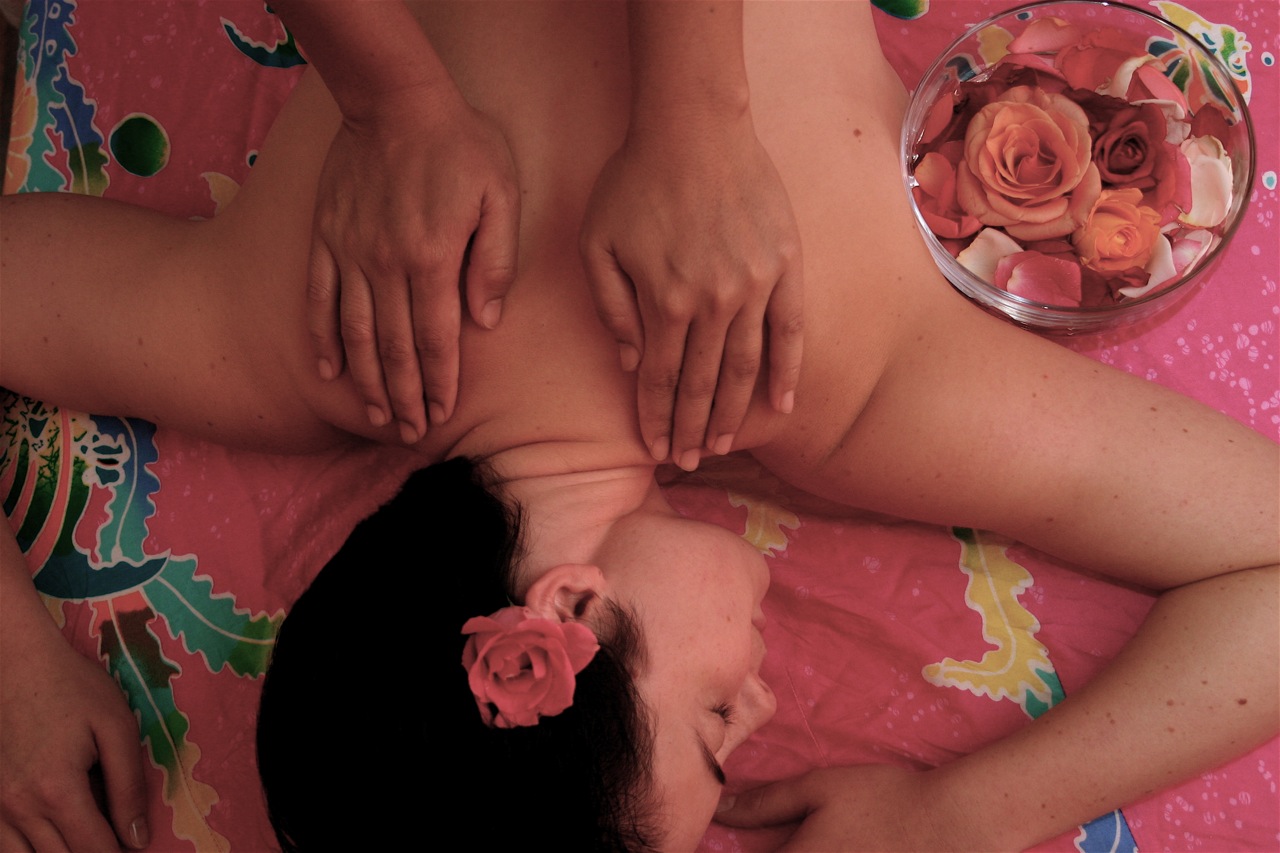
Massage is the treatment and practice of manipulation of the soft body tissues with physical, functional, i.e. mechanical, medical/therapeutic, and in some cases psychological purposes and goals.[1] The word comes from the French massage "friction of kneading," possibly from Arabic massa "to touch, feel, handle" or from Latin massa "mass, dough". [2][3] (In distinction the ancient Greek word for massage itself was anatripsis [4], and the Latin was frictio.)
Massage involves acting and manipulating the patient's body with pressure (structured, unstructured, stationary, and/or moving), tension, motion, or vibration done manually or with mechanical aids. Target tissues may include muscles, tendons, ligaments, skin, joints, or other connective tissue, as well as lymphatic vessels, and/or organs of the gastrointestinal system. Massage can be applied with the hands, fingers, elbows, forearm, and feet. There are over eighty different massage modalities. [5] The most cited reasons for introducing massage was patient demand and perceived clinical effectiveness.[6]
In professional settings, massage involves the client being treated while lying on a massage table, sitting upright in a massage chair, or lying on a pad on the floor. Except for modalities such as Acupressure, Shiatsu, Tui Na, Thai Massage, or Barefoot Deep Tissue, the massage subject is generally unclothed or partially unclothed, also referred to as disrobed, and their body would be "draped" with towels or sheets.
History
Ancient and medieval times
Writings on massage have been found in many ancient civilizations such as Rome, Greece, Japan, China, Egypt, and India. [5]Hippocrates wrote in 460 BC that "The physician must be experienced in many things, but assuredly in rubbing." [7] The ancient Chinese book called Huangdi Neijing by the Yellow Emperor recommended "massage of skin and flesh."[8] The technique of massage abortion, involving the application of pressure to the pregnant abdomen, has been practiced in Southeast Asia for centuries. One of the bas reliefs decorating the temple of Angkor Wat in Cambodia, dated circa 1150, depicts a demon performing such an abortion upon a woman who has been sent to the underworld. This is believed to be the oldest known visual representation of abortion.[9] In Romania some illnesses were treated by a massage in which the patient was treaded on by a tame bear.[10].
Modern times
United States: Massage started to become popular in the United States in the middle part of the 1800s [5] and was introduced by two New York physicians based on Per Henrik Ling's techniques developed in Sweden. [7]
During the 1930s and 1940s massage's influence decreased because of recent medical advancement, while in the 1970s massage's influence grew once again with a notable rise among athletes. [5] Massage was used up until the 1960s and 1970s by nurses to help ease patients’ pain and help them sleep.[11]
Because it is illegal to advertise or offer sexual services in most of the United States, such services are sometimes advertised as "massage".
United Kingdom: Massage is popular in the United Kingdom today and gaining. There are many private practitioners working from there own premises as well as those who operate from commercial venues.
Massage in sports, business and organizations: The 1996 Summer Olympics in Atlanta was the first time that massage was offered as a core medical service. [8] Massage has been employed by businesses and organizations such as the U.S. Department of Justice, Boeing and Reebok.[12]
Equipment
Massage Table
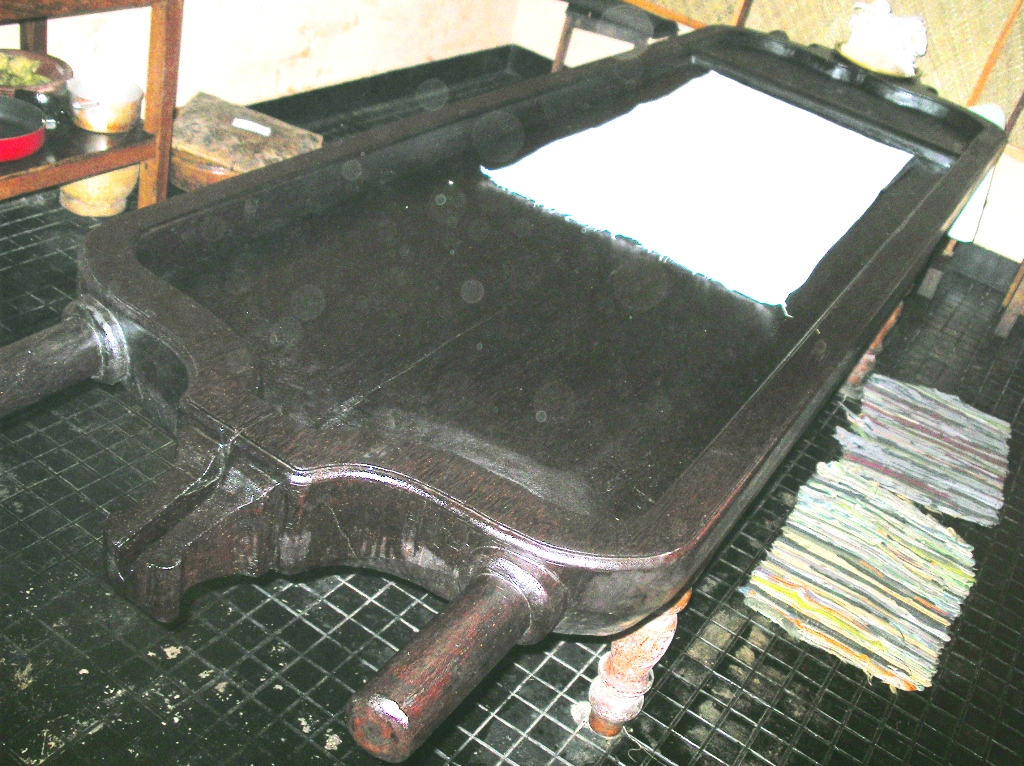
A typical commercial massage table has an easily cleaned, heavily padded surface, and a horseshoe-shaped head support that allows the client to breathe easily while lying face down and can be stationary or portable. An orthopedic pillow or bolster can be used to correct body positioning.
Massage Chair
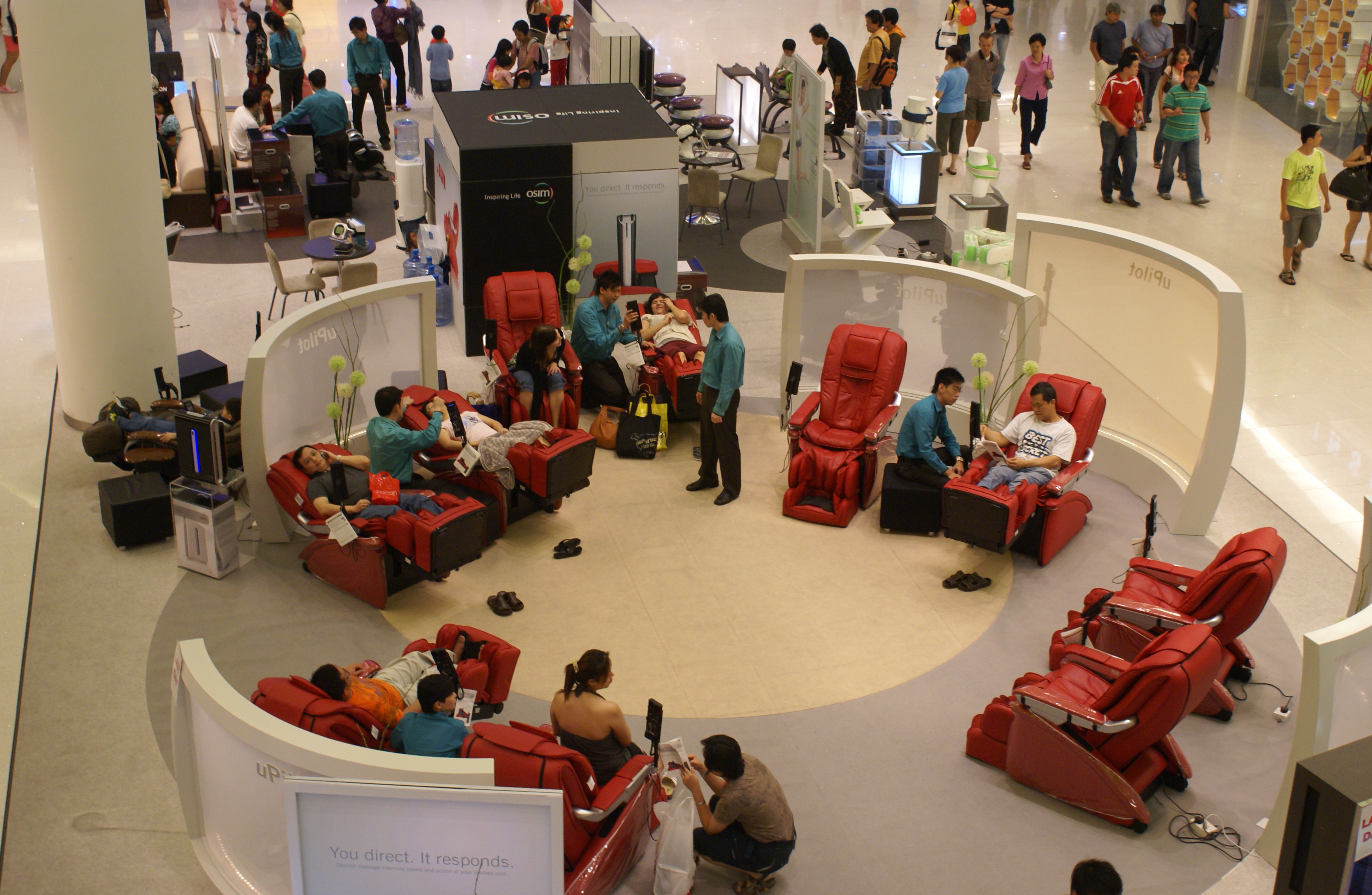
Ergonomically designed massage chairs for positioning a person who will be receiving a massage, similar in function to a massage table. Chairs may be either stationary or portable models.
Massage chairs are easier for the practitioner to maneuver than massage tables, and clients do not need to disrobe to receive a chair massage. Due to these two factors, chair massage is often performed in settings such as corporate offices, outdoor festivals, shopping malls, and other public locations.
Oil
Many different types of oils can be used including fractionated coconut oil, grape seed oil, macadamia oil, sesame oil, pecan oil, and mustard oil. Arnica, from the flowers or leaves of the Arnica montana. Often uses olive oil as a base when used medicinally, or almond oil when used as a massage oil.[13] Aromatherapy oils such as neroli oil and pine oil can also be mixed with carrier oils.
Mechanical aids
Electronic massage chairs are commercially available, which operate without any manual help. Lexus cars of the fourth generation LS include shiatsu and shoulder massage systems. [14]
Massage methods
- Different specialized massage methods sorted in alphabetical order.
Massage can be performed by a professional Massage Practitioner, or by other health care professionals, such as chiropractors, osteopath, Athletic trainers, and/or physical therapists. Massage therapists work in hospitals as allied health professioners, in nursing homes, sports and fitness facilities, spas, beauty salons, cruise ships, private offices, and travel to private residences or businesses. [5] Contraindications to massage include, deep vein thrombosis, bleeding disorders or taking blood thinners such as Warfarin, damaged blood vessels, weakened bones from cancer, osteoporosis, or fractures, and fever. [5]
Acupressure
Ayurvedic Abhyanga massage
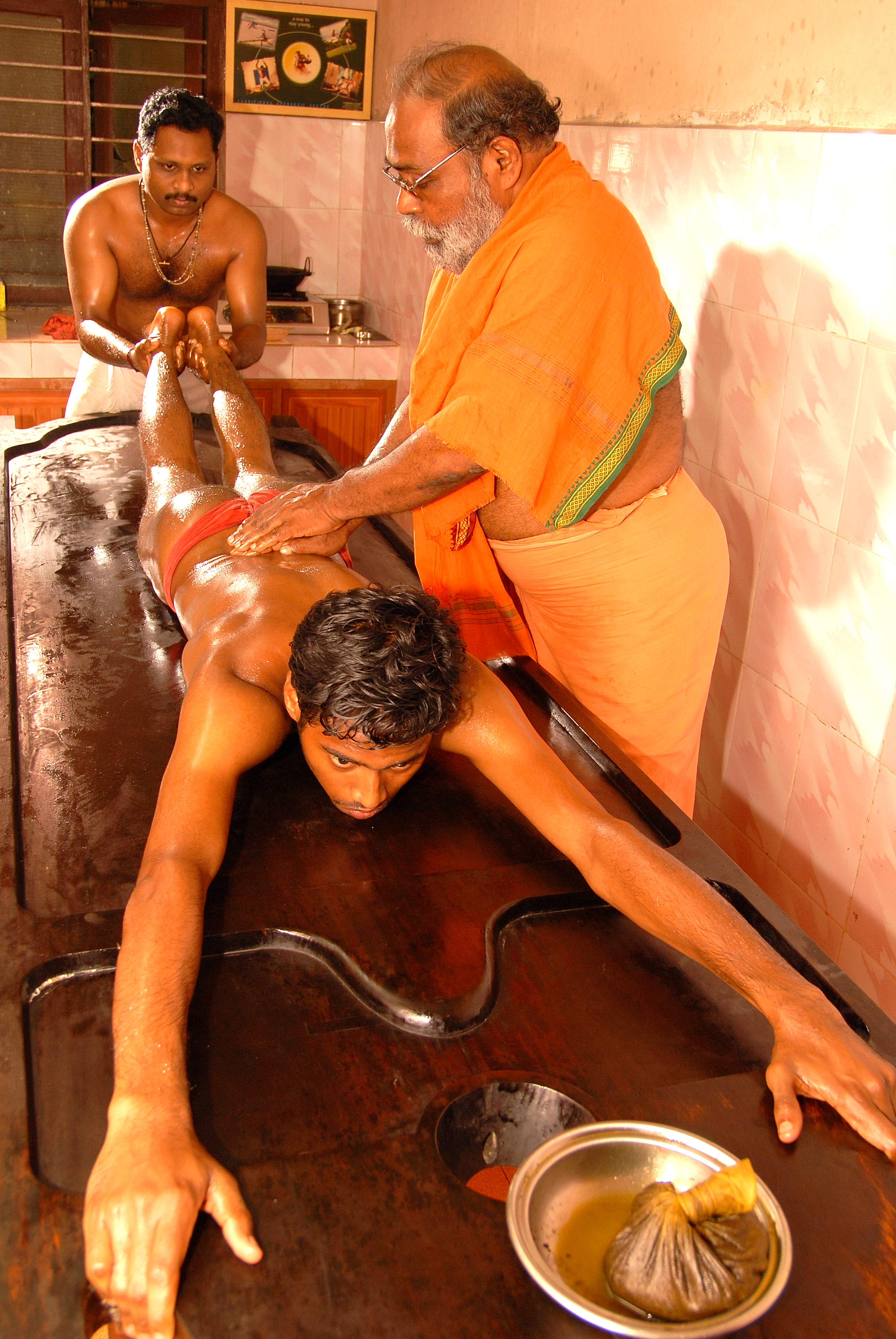
Ayurveda is a natural health care system originating in India over 5,000 years ago. It incorporates massage, yoga, meditation and herbal remedies. Ayurvedic Massage, also known as Abhyanga part of Panchakarma is usually performed by one or two therapists using a heated blend of herbal oils that are believed to be based on the body's dosha.The aim is to loosen the excess doshas through techniques such as kneading, rubbing, and squeezing. The feet are used in chavutti thirummal, a specialized technique where the therapist suspends himself by a rope from the ceiling to apply extra pressure with his feet.
Barefoot deep tissue
Barefoot deep tissue is a blend of Eastern barefoot techniques with Western manual therapy. Clients typically wear loose clothes while lying on a mat on the floor in supine, prone and side-lying positions with pillows or bolsters with no oil used. Because the therapist can apply a broad range of pressure with ease and does not have to strain, more effort and concentration can be used to sense and manipulate tissue, release fascia, as well as search for and attack trigger points, regardless of client's size or build. John Harris, who worked in the 1984 Olympics developed this modality.
Bowen therapy
Bowen technique involves a rolling type movement over fascia, muscles, ligaments, tendons and joints. It is said not to involve deep or prolonged contact with muscle tissues as in most kinds of massage, but claims to relieve muscle tensions and strains and to restore normal lymphatic flow. It is based on practices developed by Australian Tom Bowen.[15]
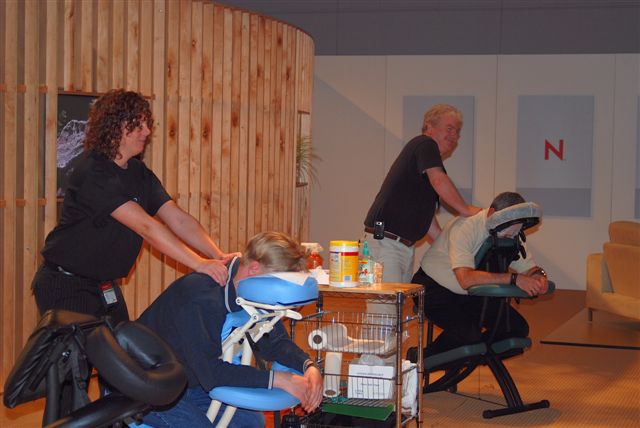
Breema
Breema bodywork is performed on the floor with the recipient fully clothed. It consists of rhythmical and gentle leans and stretches. Fifty minute sessions are common. There are also self-Breema exercises. The essence of Breema is expressed in the Nine Principles of Harmony.
Chair massage
"Seated massage" (also refereed to as chair-massage), is done in a variety of diverse settings, e.g., business,corporate and clinical settings, and in public areas such as airports, shopping centers, sport clubs, and salons. A seated-massage typically lasts 10-30 minutes, and is performed while fully clothed. Seated massage is an excellent technique to use for working on the neck, shoulders and upper back areas of the body. Due to the way the individual is positioned, seated massage allows the therapist to work with the force of gravity while doing a treatment.
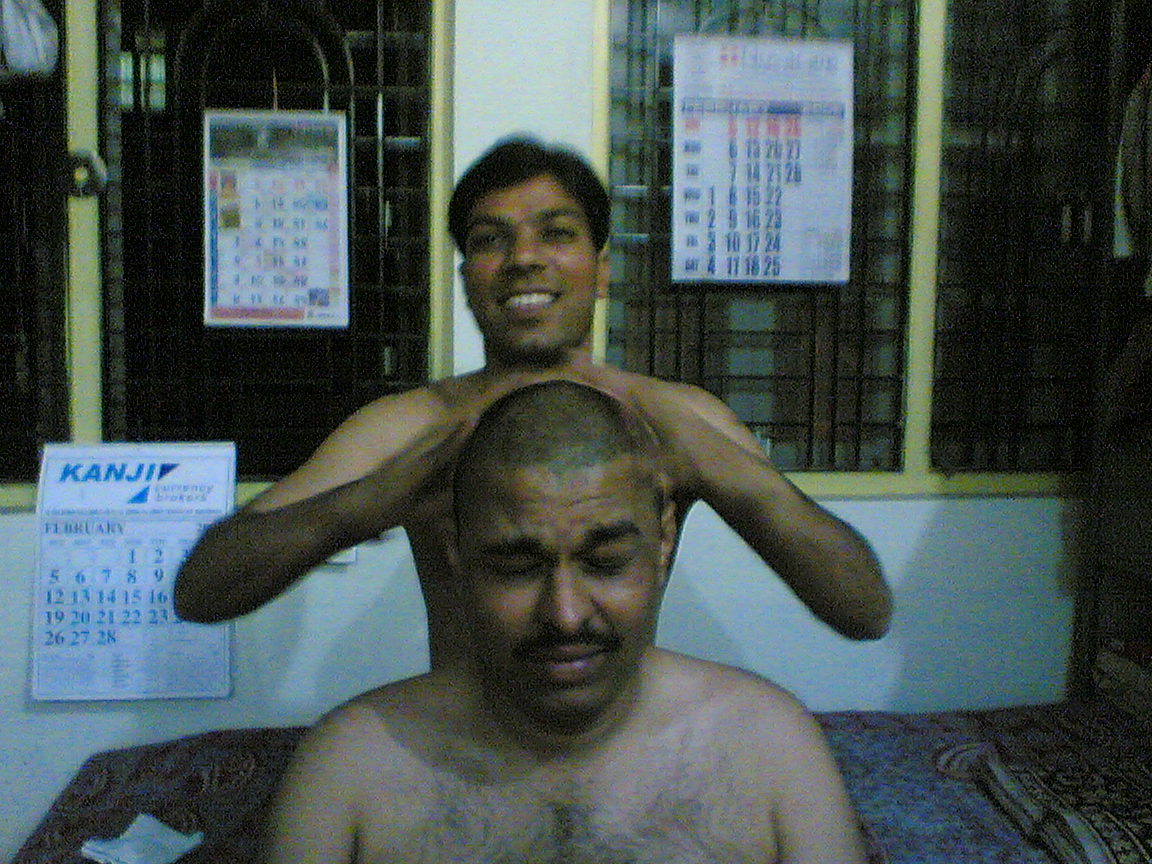
Champissage
Champissage or (Indian head massage) has been used in India for centuries. It combines massage with the more subtle form of chakra balancing. It is normally done by applying oil over the body. Also called 'champi' or Maalis. The word shampoo in English usage dates back to 1762, with the meaning "to massage". The word was a loan from Anglo-Indian shampoo, in turn from Hindi chāmpo (चाँपो Template:IPA), imperative of chāmpnā (चाँपना Template:IPA), "to smear, knead the muscles, massage". It itself comes from Sanskrit/Hindi word "champā" (चम्पा Template:IPA), the flowers of the plant Michelia champaca which have traditionally been used to make fragrant hair-oil. It is often performed by the barber after a haircut on the head, shoulders, arms, and neck.
The term and service was introduced by a Bengali entrepreneur Sake Dean Mahomed, who opened a shampooing bath known as 'Mahomed's Indian Vapour Baths' in Brighton, England in 1759.
Craniosacral therapy
Craniosacral therapy is a gentle, hands-on method of evaluating the functioning of the craniosacral system, and is often mistakenly referred to as a type of massage. It works through using the body's own self-correcting mechanisms rather than the application of physical force from the practitioner. When used by a massage practitioner, craniosacral therapy can usefully complement the massage treatment,
Deep tissue massage
Deep tissue techniques are generally designed for more focused massage work. Working a specific joint, muscle or muscle group, the practitioner can access deeper layers of the soft tissue. Starting superficially and easing into the depth of the muscle slowly often allows more movement. If the pressure is applied too deeply or too quickly, the muscle may tighten to protect that area, and unnecessary damage or inflammation can be induced. Very little lubricant is used as the pressure doesn't travel much over the skin.
The most commonly used 'tools' during deep tissue massage may include, 3 and 6 fingers, reinforced fingers, knuckles, a flat elbow, opposing thumbs, the heel of the hand or foot, and the forearm. Deep tissue is similar to Myofascial Release.
Deep muscle therapy was created by Therese Pfrimmer of Canada.
Horstmann technique
Practical technique that works by initially balancing the "energy field" and then holding on special energy points while mobilising limbs.
Esalen Massage
Esalen Massage was developed by Charlotte Selver and works with gentle rocking of the body, passive joint exercises and deep structural work on the muscles and joints, together with an energetic balancing of the body.
Infant massage
Shantala massage is an ancient Indian massage technique with a rhythmic character, given to massage babies and children. It was introduced into Western society by Dr. Frederique Leboyer, a French obstetrician.
Lomilomi
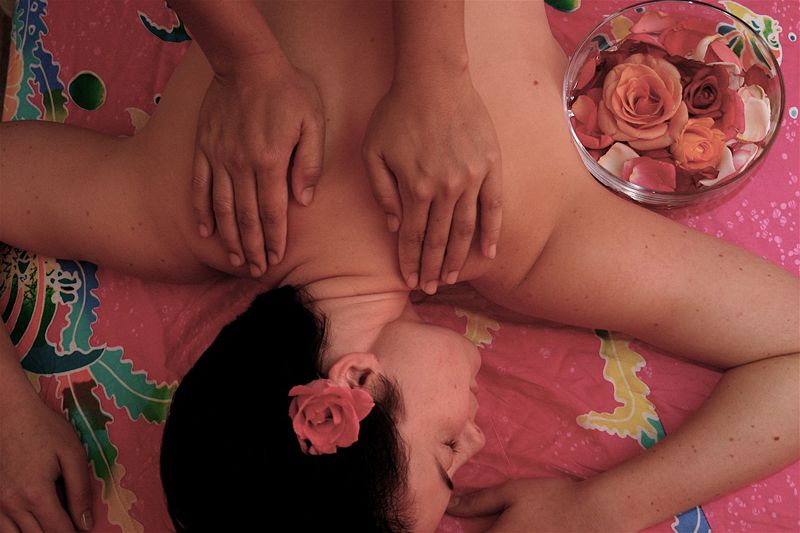
Lomilomi is the traditional massage of Hawaii. As an indigenous practice, it varies by island and by family. The styles most known today are those of Auntie Margaret Machado of the island of Hawaii, Uncle Kalua Kaiahua of Maui and Oahu, and Kahu Abraham Kawaii of Kaua'i, who called his style Kahuna Bodywork. Other names given to massage performed in Hawaii are temple style, lomi lomi, lomi lomi nui, romi kapa rere, romi romi and ma-uri. Some of these styles may be traditional, and others may have been influenced by or created in modern times. The purported Lomilomi massage given by Barbra Streisand to Robert De Niro in "Meet the Fockers" was not an accurate representation of the style.
Medical massage
Massage used in the medical field includes Manual lymphatic drainage used for lymphedema [5] which can be used in conjunction with the treatment of breast cancer. Carotid sinus massage is used to diagnose carotid sinus syncope and is sometimes useful for differentiating supraventricular tachycardia (SVT) from ventricular tachycardia. It, like the valsalva maneuver, is a therapy for SVT.[16] However, it is less effective than pharmaceutical management of SVT with verapamil or adenosine.[17]
Myofascial release
Myofascial release refers to the manual massage technique for stretching the fascia and releasing bonds between fascia, integument, and muscles with the goal of eliminating pain, increasing range of motion and equilibrioception. Injuries, stress, trauma, overuse and poor posture can cause restriction to fascia. This is usually done by applying shear compression or tension in various directions, or by skin rolling. Myofascial release originators come from Physical Therapy and from Structural Integration (Rolfing); its current developers include John Barnes, Art Riggs, Michael Stanborough, Tom Myers, Til Luchau and Michael Leahy, the originator of a complete regime called Active Release Technique or ART.
Proprioceptive Neuromuscular Facilitation (PNF) and myofacial techniques are believed to lengthen tight/facilitated muscles while fiber activation techniques are believed tone weak/inhibited muscles.
Neuromuscular therapy
Neuromuscular Therapy (NMT) is used for pain relief. Perceived imbalances in Human position are assessed initially through a postural assessment. These are then addressed through systematic and site specific massage. NMT was developed in the 1930s by Dr. Stanley Leif, current practitioners include Paul St. John.
Nihon Kaifuku Anma - Traditional Japanese massage
Introduced to Japan about 1300 years ago. Anma is deep tissue work using no oils and is based on kneading movements. Shiatsu massage grew out of this rich tradition.
Pregnancy massage
Doulas will often use massage in an attempt to smooth the labor process.
Reflexology massage
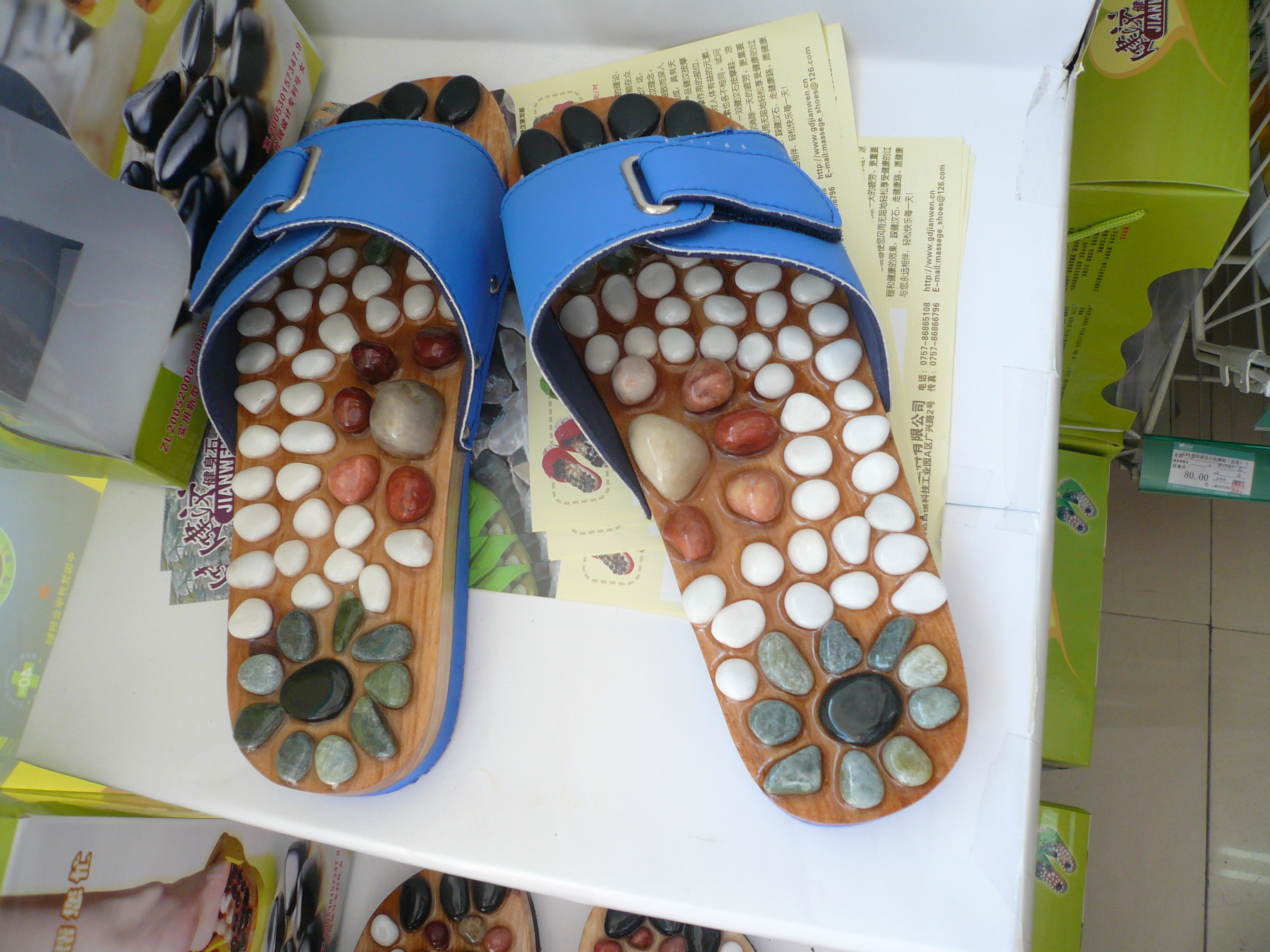
Reflexology, also called Foot zone therapy, is traditionally practiced without lotion, as the pressure points on the feet are stimulated by thumb and finger walking, as well as static pressure. Foot massage practitioners believe that the ailment of an internal organ will be associated with the nerve ending on the sole of the foot. As pressure is applied to the sole, theory holds that a healthy patient should not feel any strong pain. This theory is based on a perceived energetic flow of "meridians" in the body, also known as Chi.
Before the massage, the patient's feet are soaked for about ten minutes in a foot bath, typically a solution of hot water and Chinese herbs. The practitioner rubs and massages the painful spots to break down rough spots and accumulated crystals which have not been scientifically researched. Based on this idea, some shoe liners are made with pressure points to stimulate the soles of the feet.
Shiatsu
Shiatsu (指圧) is a form of Japanese massage that uses thumb pressure and works along the same energy meridians as acupressure and incorporates stretching. While receiving Shiatsu, you are fully clothed while laying on a mat on the floor.
Soft tissue therapy
Treatment techniques include trigger point therapy, myofascial Release, friction for adhesions between fascial layers and muscles. Sustained finger pressure to alleviate hypertonic, or tight, areas within muscle and fascia, active Release therapies, and deep tissue massage are all derivatives of soft tissue therapy. Different types of stretching such as static stretching, dynamic stretching, and/or PNF stretching (proprioceptive neuromuscular facilitation).
Another form of Soft tissue therapy is Muscle energy technique (MET) which uses reciprocal inhibition (RI) which is when the therapist uses a client’s muscle to stretch the opposing muscle. The therapist takes the muscle that they are wishing to stretch to its full range of motion. The therapist then gets the client to use the opposing muscle by moving away from the therapist. When the client relaxes the therapist then moves the muscle in an attempt to realign the muscle fibers.
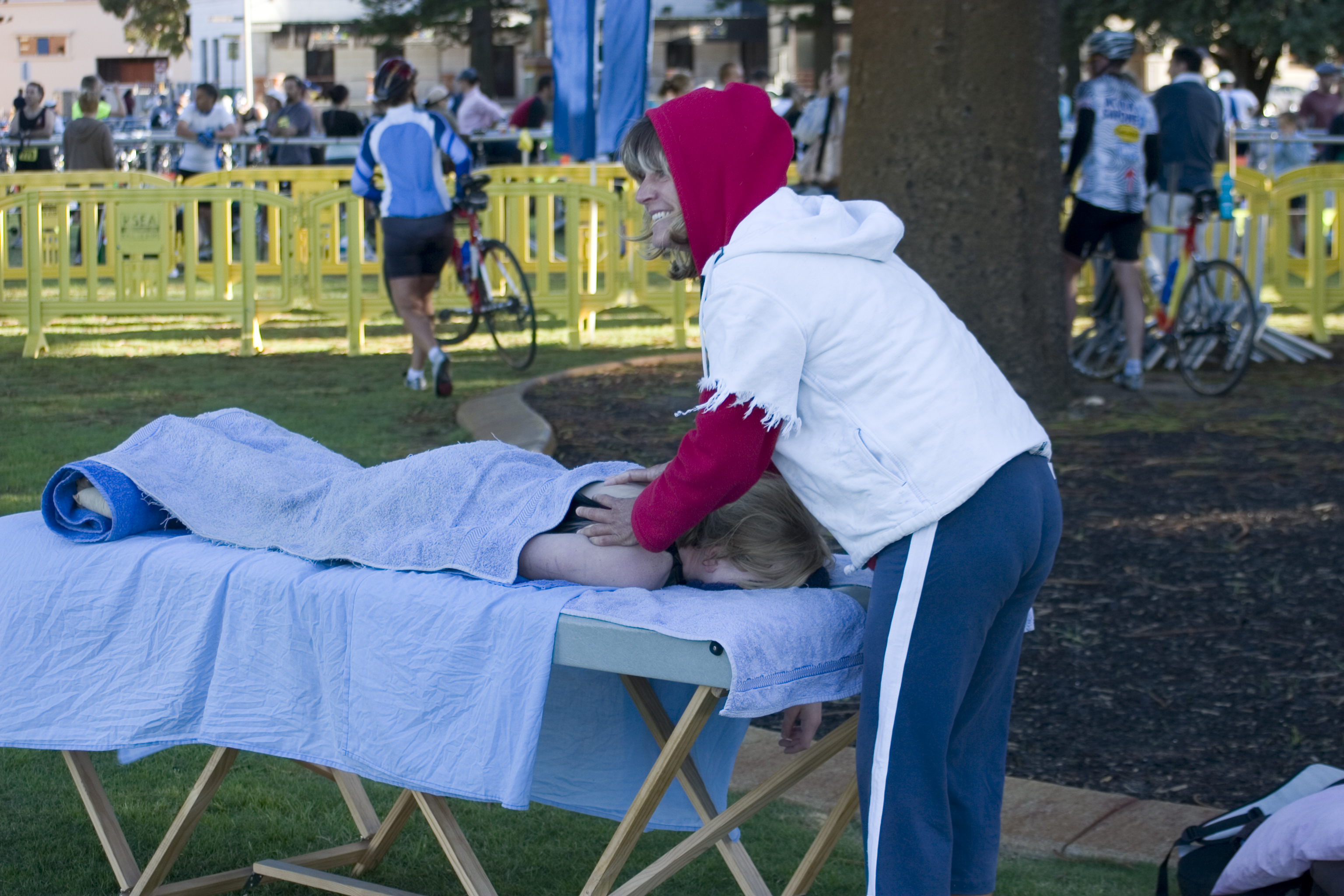
Sports massage
A Sports Massage can be described as massage that has derived from the Swedish style massage specifically to treat sporting injuries and sports persons, pre and post-event. The same techniques of effleurage, petrissage, friction, tapotement, compression, and vibration are employed; however, the movements are often reinforced, which makes the effect much deeper, and are usually targeted towards specific muscles and tissues to treat them in isolation, as well as holistically. A Sports Massage may involve treating the entire body, as part of a training routine, or more usually a specific area is treated due to a particular muscle strain or injury. Due to the nature of various sports and athletic pursuits, clients may attend for treatment with recent injuries. Direct pressure over the injury site is specifically contra-indicated for 48-72 hours after the occurrence; this over and above the standard massage contra-indications.
Neuro Muscular Technique (NMT) and Muscle Energy Technique (MET) are often used by the Sports Massage Therapist to treat high degrees of tension or 'knotting' of specific muscles. These techniques are extremely useful in relaxing the muscles sufficiently to allow the therapist perform a more standard massage routine.
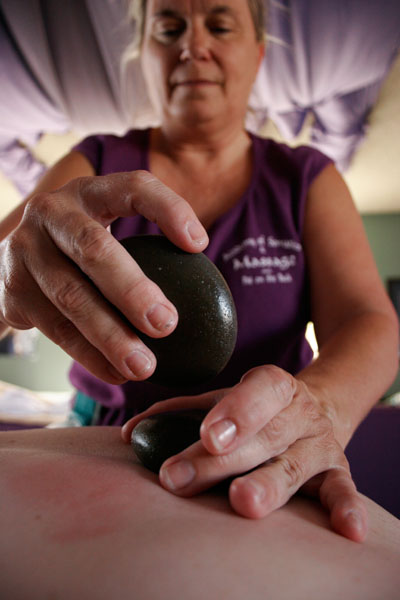
Stone massage
Heated stones were used by Egyptians, Native Americans and in Lomilomi massage. Smooth hot or cold stones, usually basalt or marble, are used to massage the body. When heated stones are used, muscles relax, allowing the massage therapist to work deeper into the muscle. Energy medicine is sometimes incorporated into stone massage. Stones are heated in hot water and are placed under the back, along both sides of the spine, and on top of the torso and are believed to heat the chakra or meridians centers. Heated stones coated in oil are then used directly in the hands of the therapist delivering various massaging strokes.
Structural Integration
Rolfing, a method of Structural Integration, works with realigning the body structurally and human gait.
Swedish massage
This style utilizes long, flowing strokes, often but not necessarily in the direction of the heart. There are six basic strokes: effleurage from the French effleurer, 'to skim over', petrissage from the French pétrir, 'to knead', friction, tapotement, compression, and vibration. Petrissage is a kneading movement with the whole palm or finger tips, using wringing, skin rolling, compression, and/or lifting. Petrissage is usually applied vertically to the muscle tissue. Oil, cream, or lotion is applied on the skin to reduce friction and allow smooth strokes. Effleurage consists of long, flowing or gliding strokes, performed with open hands. In many massage sessions, effleurage is used as the initial type of stroking, as it has a calming effect when performed slowly. Swedish massage has shown to be helpful in reducing pain, joint stiffness, and improving function in patients with osteoarthritis of the knee over a period of eight weeks. [18]
History
This style of massage is generally attributed to the Swedish fencing master and gymnastics teacher Per Henrik Ling (1776-1839). However, it was in fact the Dutch practitioner Johan Georg Mezger (1838-1909) who adopted the French names to denote the basic strokes. The term Swedish Movement System was transposed to Swedish Massage System sometime during the second half of the 19th century. Ling’s system was the Swedish Movement System or Swedish Gymnastic Movement System. This may be how he has become incorrectly associated for so long with Swedish massage. [19]
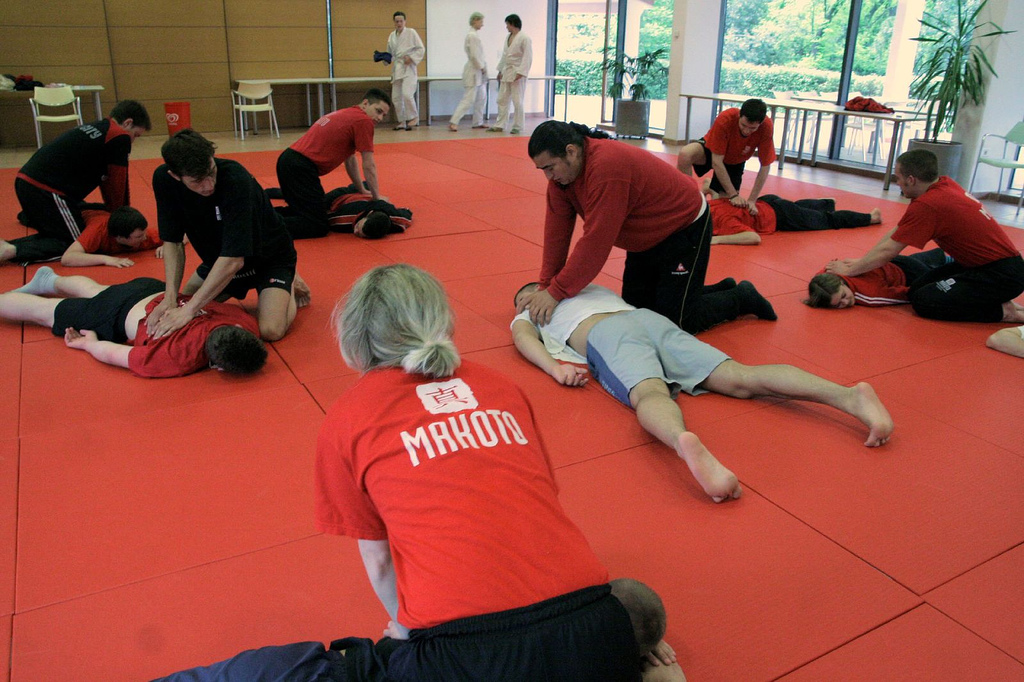
Tai Ji/Tai Chi massage
This massage uses the natural principles of Yin and Yang to achieve balance in the energies of the body. Practitioners of Tai Ji believe that it uses Tao and deals with Qi blockages.
Thai massage
Known in Thailand as นวดแผนโบราณ (Nuat phaen boran, IPA Template:IPA), meaning "ancient/traditional massage", Thai massage is also known as Thai ancient massage, traditional Thai massage, Thai yoga massage, yoga massage, Thai classical massage, Thai bodywork, passive yoga or assisted yoga. Thai massage originated in India based and is based on Ayurveda and yoga, thereafter becoming popular in ancient Siam, now known as Thailand. It was believed that the massage art was brought over to Thailand by Shivago Komarpaj (Jivaka Kumarabhacca), a contemporary of Gautama Buddha over 2500 years ago. The receiver is put into many yoga like positions during the course of the massage. In the northern style based out of Chiang Mai, Thailand there is a lot of stretching movements, unlike the southern style where acupressure is emphasized.
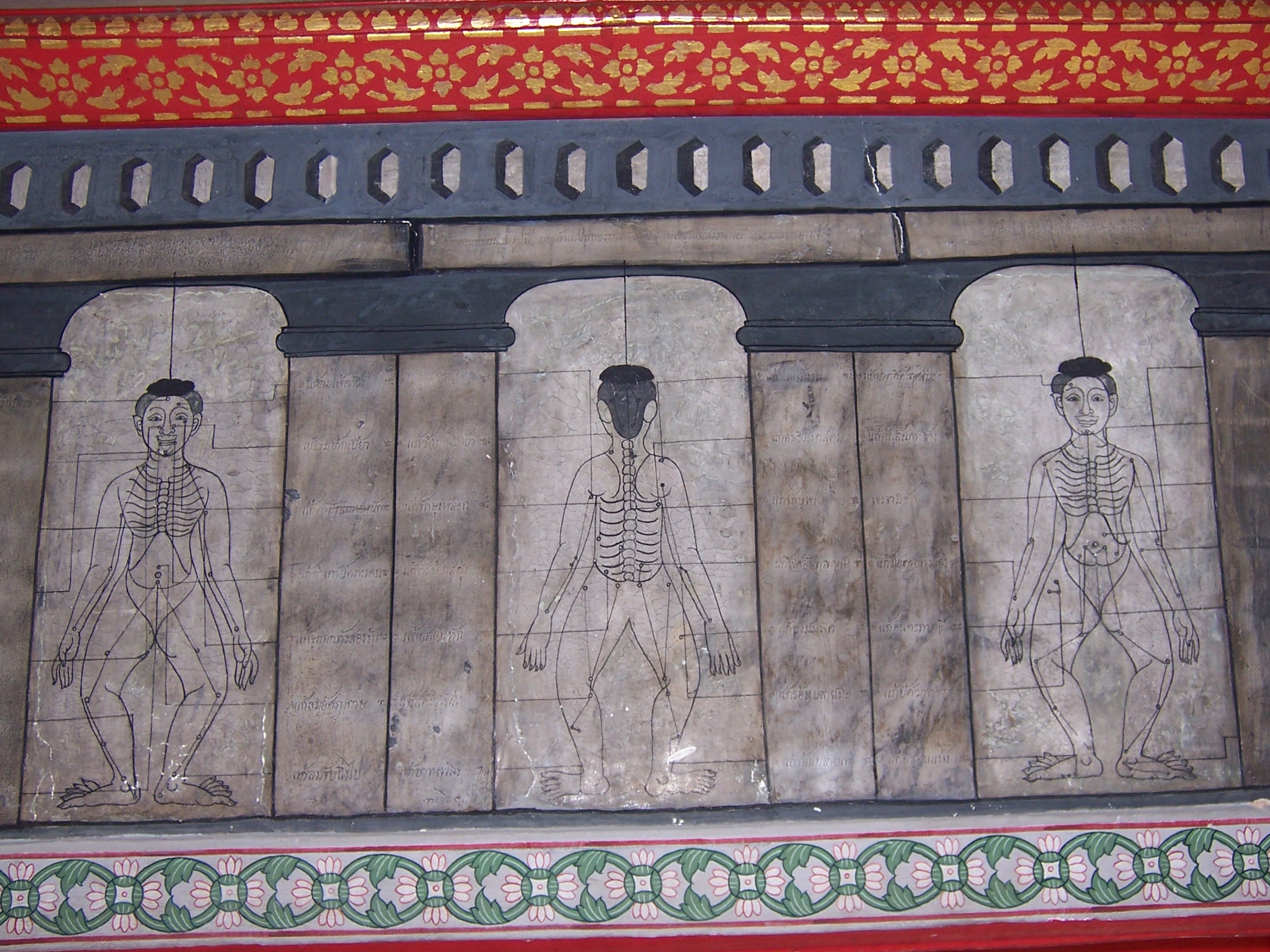
The massage recipient changes into loose, comfortable clothes and lies on a mat or firm mattress on the floor. (It can be done solo or in a group of a dozen or so patients in the same large room.) The massage practitioner leans on the recipient's body using hands and usually straight forearms locked at the elbow to apply firm rhythmic pressure. The massage generally follows the Sen lines on the body — somewhat analogous to meridians or Channel (Chinese medicine) and Indian nadis. Legs and feet of the giver can be used to fixate the body or limbs of the recipient. In other styles, hands fixate the body, while the feet do the massaging action. Oil is not used in traditional Thai Massage. A full Thai massage session typically lasts two hours or more, and includes rhythmic pressing and stretching of the entire body; this may include pulling fingers, toes, ears, cracking the knuckles, walking on the recipient's back, and arching the recipient's into bhujangasana or (cobra position). There is a standard procedure and rhythm to this massage. In Thailand a two hour massage might cost around 300 Thai baht (US $8 in 2005) depending on location (it may cost ten times more inside a five star hotel).
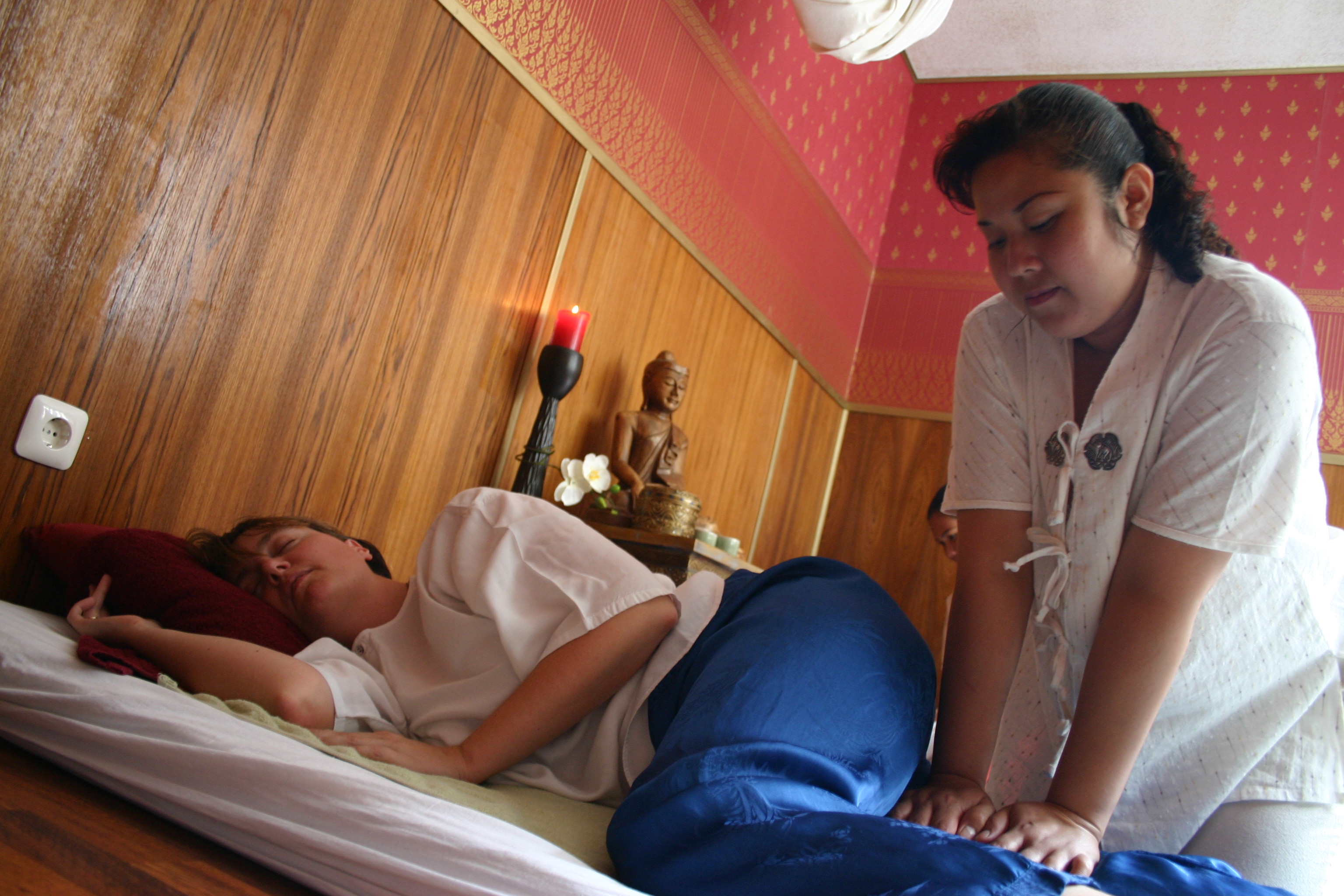
Note: The traditional therapeutic practice of Thai massage should not be confused with the sexual service of the same name that is available in some hotels and brothels. Sometimes the traditional therapeutic Thai Massage, or ancient massage, is referred to as "old lady massage", while the sexual practice, which has nothing to do with therapeutic traditional massage is called "young lady massage".
Traditional Chinese massage
Tui Na (推拿) focusing on pushing, stretching and kneading the muscle. Zhi Ya (指壓) is similar to Tui Na massage except it focuses more on pinching and pressing at acupressure points. They are both based on principles from Traditional Chinese Medicine.
Trager Approach
The Trager Approach combines movement, massage and education.
Trigger point therapy
This can also be called pressure point massage. [5] A trigger point is an area of a muscle (about 50 cells) that may refer pain sensations to other parts of the body. Manual pressure is applied to these points. This work was founded by Dr. Janet G. Travell, U.S. President John F. Kennedy's physician and David Simons. This work can be incorporated into other styles of massage therapy such as neuromuscular therapy (NMT) or Swedish.
Visceral manipulation
One form is Mayan abdominal massage which is practiced in many countries in Latin America. This type of massage was developed by Don Elijio Panti and Dr. Rosita Arvigo of Peru.
Mantak Chia introduced a form of abdomen massage called Chi Nei Tsang, which he teaches, helps to "clears negative emotions" (in the form of "bad winds" or "sick winds") which gather near the navel.[20]
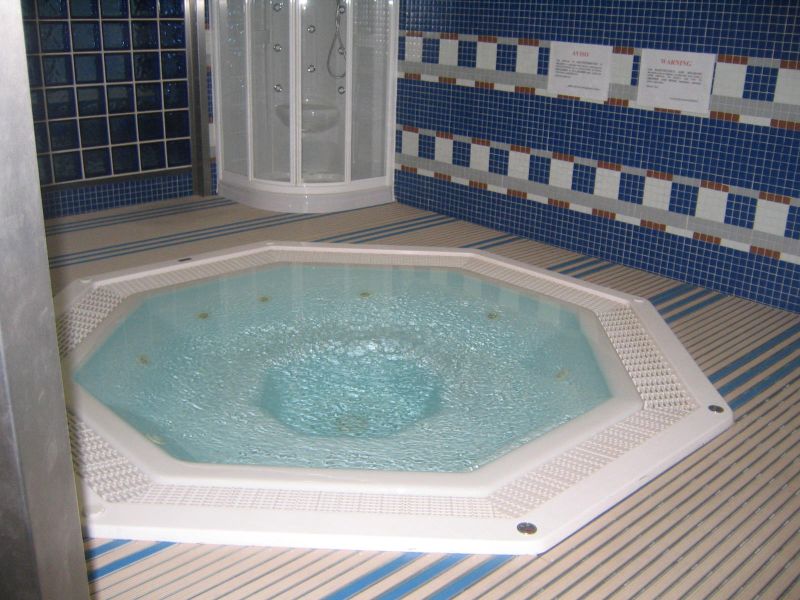
Watsu
Watsu is the combination of hydrotherapy and Shiatsu developed by Harold Dull in his time spent at Harbin Hot Springs near Middletown, California, USA. The work is done in skin temperature water with both the therapist and practitioner in the water, usually a pool which is between 3.5 ft to 4 ft. (100–120 cm) deep. The work entails much movement in the water and practitioners believe that it incorporates the activation of the energy lines derived from Shiatsu.
Associated methods
Many types of practices are associated with massage and include Bodywork (alternative medicine), manual therapy, energy medicine, and breathwork. Other names for massage and related practices include hands-on work, body/somatic therapy, and somatic movement education. Body-mind integration techniques stress self-awareness and movement over physical manipulations by a practitioner. Therapies related to movement awareness/education are closer to Dance and movement therapies. Massage can also have connections with the New Age movement and alternative medicine as well as being used by mainstream medical practitioners.
Beneficial effects
Peer-reviewed medical research has shown that the benefits of massage include pain relief, reduced trait anxiety and depression, and temporarily reduced blood pressure, heart rate, and state anxiety.[21] Theories behind what massage might do include blocking nociception (gate control theory), activating the parasympathetic nervous system which may stimulate the release of endorphins and serotonin, preventing fibrosis or scar tissue, increasing the flow of lymph, and improving sleep[5] but such effects are yet to be supported by well designed clinical studies.
Massage is hindered from reaching the gold standard of scientific research which includes placebo-controlled and double blind clinical trials.[22] [23] Developing a "sham" manual therapy for massage would be difficult since even light touch massage could not be assumed to be completely devoid of effects on the subject.[22] It would also be difficult to find a subject that would not notice that they were getting less of a massage and it would be impossible to blind the therapist.[22] Massage can employ randomized controlled trials which are published in peer reviewed medical journals.[22] This type of study could increase the credibility of the profession because it displays that purported therapeutic effects are reproducible.[23]
Single dose effects
Pain relief: Relief from pain due to musculoskeletal injuries and other causes is cited as a major benefit of massage.[5] In one study, cancer patients self-reported symptomatic relief of pain.[24] [25] This study, however, did not include a no treatment or placebo control group so these effect may be due to the placebo effect or regression towards the mean. Massage can also relieve tension headaches. Acupressure or pressure point massage may be more beneficial than classic Swedish massage in relieving back pain.[26] However, a meta-study conducted by scientists at the University of Illinois at Urbana-Champaign failed to find a statistically significant reduction in pain immediately following treatment. [21]
State anxiety: Massage has been shown to reduce state anxiety, a transient measure of anxiety in a given situation. [21]
Blood pressure and heart rate: Massage has been shown to reduce blood pressure and heart rate as temporary effects. [21]
Attention: After massage, EEG patterns indicate enhanced performance and alertness on mathematical computations, with the effects perhaps being mediated by decreased stress hormones.
Other: Massage also stimulates the immune system[27] by increasing peripheral blood lymphocytes (PBLs). However, this immune system effect is only observed in aromatherapy massage, which includes sweet almond oil, lavender oil, cypress oil, and sweet marjoram oil. It is unclear whether this effect persists over the long term.
Multiple dose effects
Pain relief: When combined with education and exercises, massage might help sub-acute, chronic, non-specific low back pain. [28] Furthermore, massage has been shown to reduce pain experienced in the days or weeks after treatment. [21]
Trait anxiety: Massage has been shown to reduce trait anxiety; a person's general susceptibility to anxiety. [21]
Depression: Massage has been shown to reduce subclinical depression. [21]
Diseases: Massage, involving stretching, has been shown to help with spastic diplegia resulting from Cerebral palsy in a small pilot study.[29] The researchers warn that these results should "be viewed with caution until a double-blind controlled trial can be conducted".
Massage has been used in an effort to improve symptoms, disease progression, and quality of life in HIV patients, however, this treatment is not scientifically supported.[30]
Regulation
In the USA there are about 90,000 massage therapists. [7] Training programs in the US are typically 500–1000 hours in length, and can award a certificate, diploma, or degree depending on the particular school. [31] There are around 1,300 programs training massage therapists in the country and study will often include anatomy and physiology, kinesiology, massage techniques, first aid and CPR, business, ethical and legal issues, and hands on practice along with continuing education requirements if regulated. [5] The Commission on Massage Therapy Accreditation (COMTA) is one of the organizations that works with massage schools in the U.S.. [6] 38 states and the District of Columbia require some type of licencing for massage therapists. [32] In the US, 32 states use the National Certification Board for Therapeutic Massage and Bodywork's certification program as a basis for granting licenses either by rule or statute. [33] The National Board grants the designation Nationally Certified in Therapeutic Massage and Bodywork (NCTMB). There are two tests available and you can become certified through a porfolio process if you have equivalent training and experience. [34] Between 10-20% of towns or counties regulate the profession. [35] These local regulations can range from prohibition on opposite sex massage, fingerprinting and venereal checks from a doctor, to prohibition on house calls because of concern reguarding sale of sexual services.[35] [36]
In the USA licensure is the highest level of regulation and this restricts anyone without a license from practicing massage therapy or by calling themselves that protected title. Certification allows only those who meet certain educational criteria to use the protected title and registration only requires a listing of therapists who apply and meet an educational requirement. [36]
In Canada only three provinces regulate massage therapy [37] they are British Columbia, Ontario, and Newfoundland and Labrador. [35] The Canadian Massage Therapists Alliance (CMTA) has set a level of 2200 practice hours in Ontario, and Newfoundland and Labrador and 3000 hours in British Columbia. [37] In India, massage therapy is licenced by The Department of Ayurveda, Yoga & Naturopathy, Unani, Siddha and Homoeopathy (AYUSH) under the Ministry of Health and Family Welfare (India) in March of 1995.
Because the art and science of massage is a globally diverse phenomenon, different legal jurisdictions sometimes recognize and license individuals with titles. Examples are:
- Registered Massage Therapist (RMT) Canada
- Certified Massage Therapist (CMT)
- Licensed Massage Practitioner (LMP)
- Licensed Massage Therapist (LMT)
- Licensed Massage and Bodywork Therapist (LMBT) North Carolina
Prevalence in the United States
In 1997 there was an estimated 114 million visits to massage therapists in the US.[31] Massage therapy is the most used type of Complementary and alternative medicine in hospitals in the United States.[6]
People state that they use massage because they believe that it relieves pain from musculoskeletal injuries and other causes of pain, reduces stress and enhances relaxation, rehabilitates sports injuries, decreases feelings of anxiety and depression, and increases general well being.[5]
In a poll of 25-35 year olds 79% said they would like their health insurance plan to cover massage.[8] Some of the companies that offer massage to their employees include Allstate, Best Buy, Cisco Systems, FedEx, Gannett (which runs USA Today), General Electric, Hewlett-Packard, Home Depot, JC Penney, Kimberly-Clark, Texas Instruments and Yahoo. In 2006 Duke University Health System opened up a center to integrate medical disciplines with CAM disciplines such as massage therapy and acupuncture[38], this trend was started by Andrew Weil. There were 15,500 spas in the United States in 2007 with about a third of the visitors being men.[32]
The number of visits rose from 91 million in 1999 to 136 million in 2003, generating a revenue that equals $11 billion.[39]
Prevalence in Asia
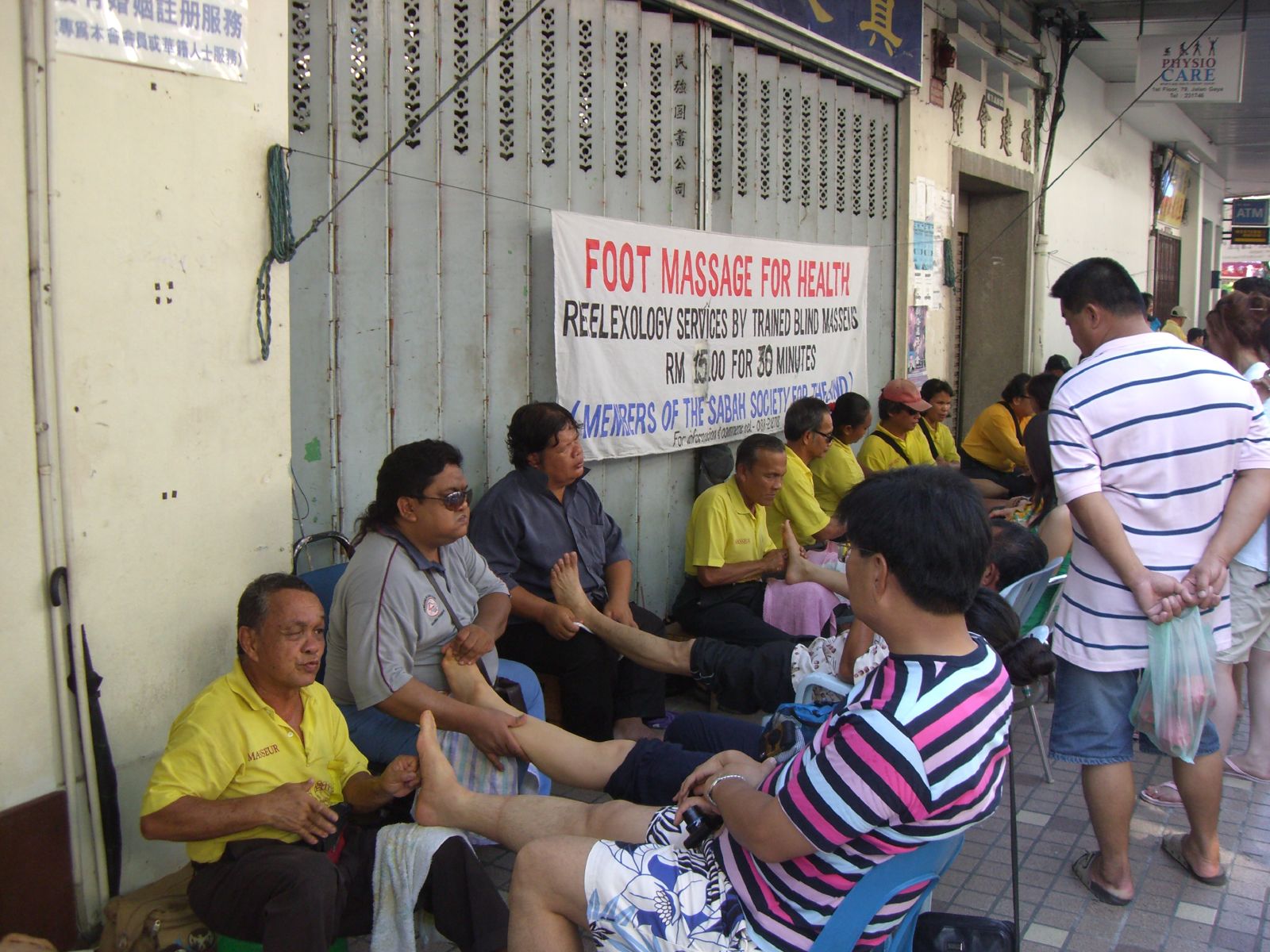
In Asia, bathroom attendants may provide a hot face towel and a massage.
Notable practitioners
Heinrich Himmler, commander of the Schutzstaffel (SS) and one of the most powerful men in Nazi Germany might have lost faith in German victory due to his discussions with his masseurs Felix Kersten and Walter Schellenberg.[40] Albert Bedane (1893–1980) who provided shelter to a Jewish woman and others during World War II was a massage/physiotherapist.
See also
References
- ↑ Definition of massage, MedicineNet.com
- ↑ Online Etymology Dictionary, massage
- ↑ Merriam Webster Dictionary Online, massage
- ↑ Calvert, R. (2002-04-01). "The History of Massage: An Illustrated Survey from Around the World". Healing Arts Press. Check date values in:
|date=(help) - ↑ 5.00 5.01 5.02 5.03 5.04 5.05 5.06 5.07 5.08 5.09 5.10 5.11 "Massage Therapy as CAM". The National Center for Complementary and Alternative Medicine (NCCAM). 2006-9-01. Retrieved 2007-09-26. Check date values in:
|date=(help) - ↑ 6.0 6.1 6.2 "Policy for Therapeutic Massage in an Academic Health Center: A Model for Standard Policy Development". The Journal of Alternative and Complementary Medicine. 2007. Retrieved 2007-09-26. Check date values in:
|date=(help) 13 (4) pp.471-475 - ↑ 7.0 7.1 7.2 "Massage Therapy". Harvard Men’s Health Watch. 2006-09-01. Retrieved 2007-09-26. Check date values in:
|date=(help) 11 (2) pp.6-7 - ↑ 8.0 8.1 8.2 "Massage Facts". National Certification Board for Therapeutic Massage & Bodywork. Retrieved 2007-09-27.
- ↑ Potts, Malcolm, & Campbell, Martha. (2002). History of contraception. Gynecology and Obstetrics, vol. 6, ch. 8.
- ↑ călcá in the Dicţionarul etimologic român, Alexandru Ciorănescu, Universidad de la Laguna, Tenerife, 1958-1966
- ↑ MacGregor, H. (2004-12-28). "Hospitals Getting a Grip: Massage Therapy Finds Place in Patient Care for FM and More". Los Angeles Times. Retrieved 2007-08-31. Check date values in:
|date=(help) - ↑ Goodman, T. (2000-12-28). "Massage craze: Hands-on therapy attracting more patients". CNN. Retrieved 2007-08-31. Check date values in:
|date=(help) - ↑ "Arnica Oil". Vitality Works. Retrieved 2006-08-11.
- ↑ "Automotive Engineering International Magazine Names Lexus LS 460 As 2007 Best Engineered Vehicle". SAE International. 2007-04-10. Retrieved 2007-05-06. Text "Society of Automotive Engineers" ignored (help)
- ↑ Bowen Therapists Federation of Australia
- ↑ Lim SH, Anantharaman V, Teo WS, Goh PP, Tan AT. Comparison of treatment of supraventricular tachycardia by Valsalva maneuver and carotid sinus massage. Ann Emerg Med. 1998 Jan;31(1):30-5. PMID 9437338
- ↑ Ballo P, Bernabo D, Faraguti SA. Heart rate is a predictor of success in the treatment of adults with symptomatic paroxysmal supraventricular tachycardia. Eur Heart J. 2004 Aug;25(15):1310-7. PMID 15288158
- ↑ Robertshawe P. (June 2007). "Massage for Osteoarthritis of the Knee". Journal of the Australian Traditional-Medicine Society. 13 (2): 87.
- ↑ Calver, R. "Pages from history: Swedish massage". Massage Magazine. Retrieved 2006-12-25.
- ↑ Chia, Mantak & Maneewan. Chi Nei Tsang: Internal Organ Chi Massage. : Healing Tao Books, 1991. ISBN 0935621350.
- ↑ 21.0 21.1 21.2 21.3 21.4 21.5 21.6 "A Meta-Analysis of Massage Therapy Research" (PDF). Psychological Bulletin. 2004. Retrieved 2008-01-12. Check date values in:
|date=(help) - ↑ 22.0 22.1 22.2 22.3 Evans, R. (2006). "What Does the Research Say?". Regents of the University of Minnesota. Retrieved 2007-12-06. Check date values in:
|date=(help) - ↑ 23.0 23.1 Muscolino, J. (2004). "Anatomy Of A Research Article" (PDF). Massage Therapy Foundation. Retrieved 2007-12-06. Check date values in:
|date=(help) - ↑ "Massage therapy for symptom control: outcome study at a major cancer center". NCBI PubMed. 2004-09-12. Retrieved 2007-09-11. Check date values in:
|date=(help) - ↑ Grealish L, Lomasney A, Whiteman B. (2000). "Foot massage. A nursing intervention to modify the distressing symptoms of pain and nausea in patients hospitalized with cancer (abstract)". PubMed NCBI. Retrieved 2006-03-07. Check date values in:
|year=(help) - ↑ Furlan A, Brosseau L, Imamura M, Irvin E. "Massage for low back pain". Cochrane Database Syst Rev: CD001929. PMID 12076429.
- ↑ Kuriyama, H. (2005). "Immunological and Psychological Benefits of Aromatherapy Massage (abstract)". Evidence-based Complementary and Alternative Medicine. 2 (2): 179–184. doi:10.1093/ecam/neh087.
- ↑ "Massage for low back pain". NCBI PubMed. 2002. Retrieved 2007-09-28. Check date values in:
|date=(help) - ↑ Macgregor R, Campbell R, Gladden MH, Tennant N, Young D (2007). "Effects of massage on the mechanical behaviour of muscles in adolescents with spastic diplegia: a pilot study". Developmental medicine and child neurology. 49 (3): 187–191. PMID 17355474.
- ↑ Saltmarsh, S. (2006). "Voodoo or valid? Alternative therapies benefit those living with HIV". Positively Aware. 3 (16): 46. PMID 16479668.
- ↑ 31.0 31.1 Kahn, J. (2005-06-10). "Overview of Manual Therapy Use in the U.S." The National Center for Complementary and Alternative Medicine (NCCAM). Retrieved 2007-09-26. Check date values in:
|date=(help) - ↑ 32.0 32.1 Stellin, S. (2007-07-15). "Beyond the Body Wrap: What Makes a Spa Stand Out?". New York Times. Retrieved 2007-09-20. Check date values in:
|date=(help) - ↑ "States that require NCBTMB exams". National Certification Board for Therapeutic Massage and Bodywork. Retrieved 2007-09-27.
- ↑ "What you need to know". National Certification Board for Therapeutic Massage and Bodywork. Retrieved 2007-09-27.
- ↑ 35.0 35.1 35.2 "Massage Therapy Law and Licensure and States Regulating Massage". Natural Healers. Retrieved 2007-09-27.
- ↑ 36.0 36.1 Walsh, K. "Massage craze: Hands-on therapy attracting more patients". Massage Magazine. Retrieved 2007-08-31.
- ↑ 37.0 37.1 Verhoef, M. (2005-06-10). "Overview of Manual Therapy in Canada". The National Center for Complementary and Alternative Medicine (NCCAM). Retrieved 2007-09-26. Check date values in:
|date=(help) - ↑ "First-of-its-Kind Center Treats the Whole Person". Massage Magazine. 2007-01. Retrieved 2007-09-27. Check date values in:
|date=(help) - ↑ Ellin, A. (2005-07-21). "Now Let Us All Contemplate Our Own Financial Navels". New York Times. Retrieved 2007-09-20. Check date values in:
|date=(help) - ↑ Crocker, Harry (2001-11-13). Triumph: A 2,000 Year History of the Catholic Church. Prima Lifestyles. ISBN 0761529241.
External links
| Wikimedia Commons has media related to Category:Massage. |
| File:Wiktionary-logo-en-v2.svg | Look up massage in Wiktionary, the free dictionary. |
Template:Massage types Template:Allied health professions Template:Nudity
be-x-old:Масаж cs:Masáž da:Massage de:Massage eo:Masaĝo id:Urut it:Massoterapia he:עיסוי lt:Masažas ms:Urut nl:Massage no:Massasje sk:Masáž fi:Hieronta sv:Massage uk:Масаж yi:מאסאזש